Wesfarmers Plc: Business and International Management Analysis
VerifiedAdded on 2023/06/10
|30
|4543
|488
AI Summary
This report analyzes the potential of Wesfarmers Plc to expand its business on an international level by setting up outlets in Singapore to sell clothes such as T-shirts, Jeans, and other stuff. It includes a situational analysis, market analysis, SWOT analysis, and recommended marketing strategies.
Contribute Materials
Your contribution can guide someone’s learning journey. Share your
documents today.
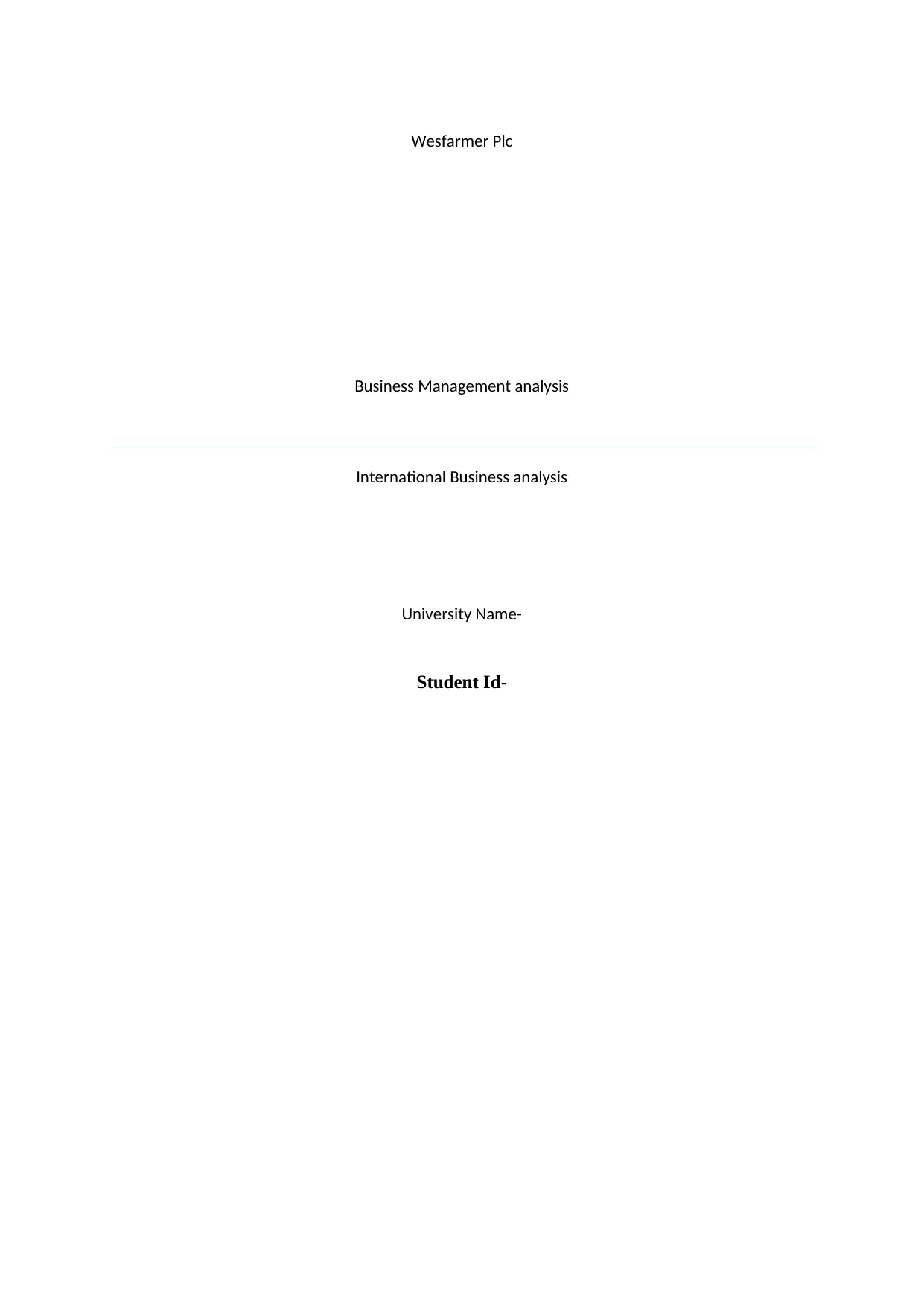
Wesfarmer Plc
Business Management analysis
International Business analysis
University Name-
Student Id-
Business Management analysis
International Business analysis
University Name-
Student Id-
Secure Best Marks with AI Grader
Need help grading? Try our AI Grader for instant feedback on your assignments.
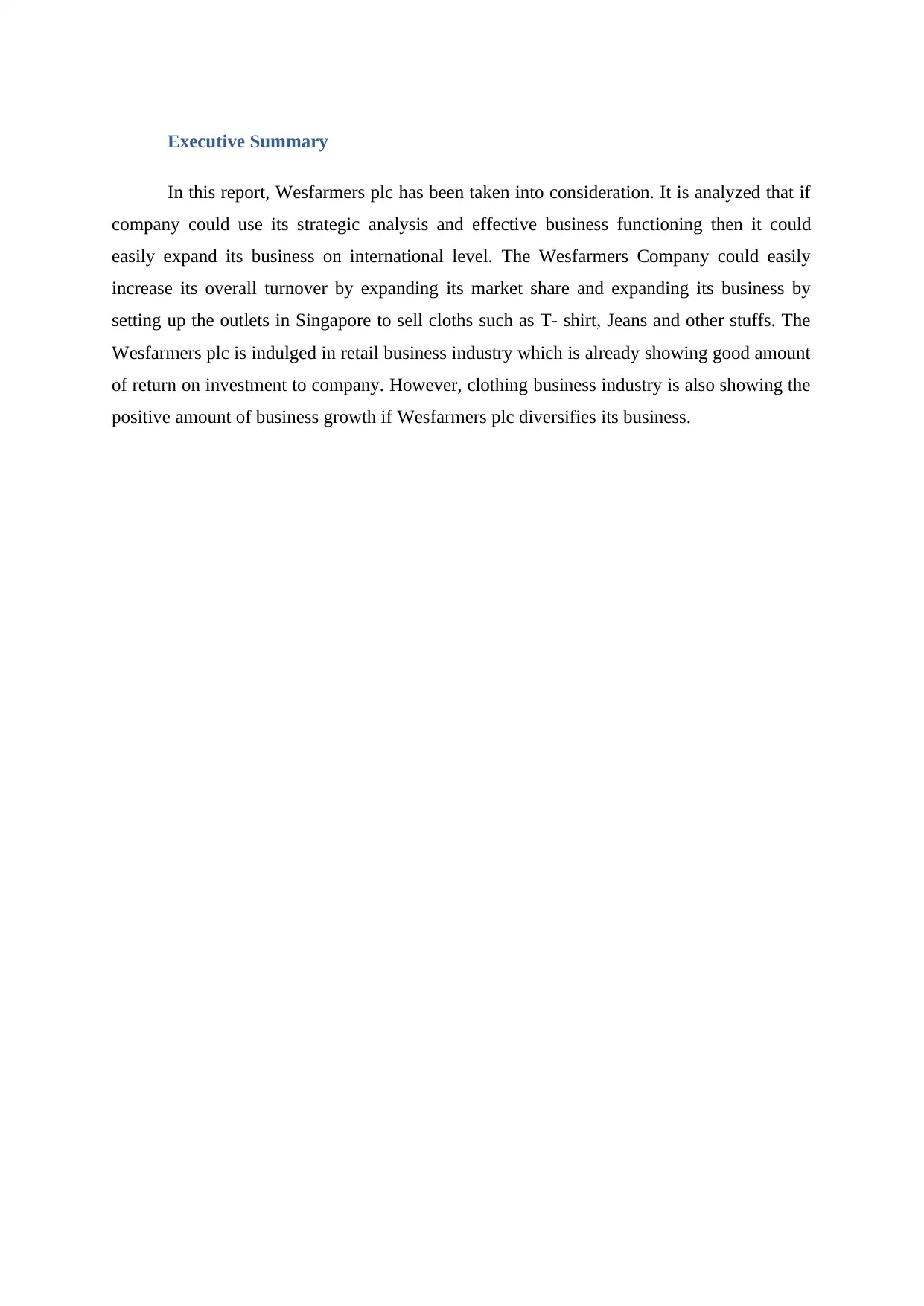
Executive Summary
In this report, Wesfarmers plc has been taken into consideration. It is analyzed that if
company could use its strategic analysis and effective business functioning then it could
easily expand its business on international level. The Wesfarmers Company could easily
increase its overall turnover by expanding its market share and expanding its business by
setting up the outlets in Singapore to sell cloths such as T- shirt, Jeans and other stuffs. The
Wesfarmers plc is indulged in retail business industry which is already showing good amount
of return on investment to company. However, clothing business industry is also showing the
positive amount of business growth if Wesfarmers plc diversifies its business.
In this report, Wesfarmers plc has been taken into consideration. It is analyzed that if
company could use its strategic analysis and effective business functioning then it could
easily expand its business on international level. The Wesfarmers Company could easily
increase its overall turnover by expanding its market share and expanding its business by
setting up the outlets in Singapore to sell cloths such as T- shirt, Jeans and other stuffs. The
Wesfarmers plc is indulged in retail business industry which is already showing good amount
of return on investment to company. However, clothing business industry is also showing the
positive amount of business growth if Wesfarmers plc diversifies its business.
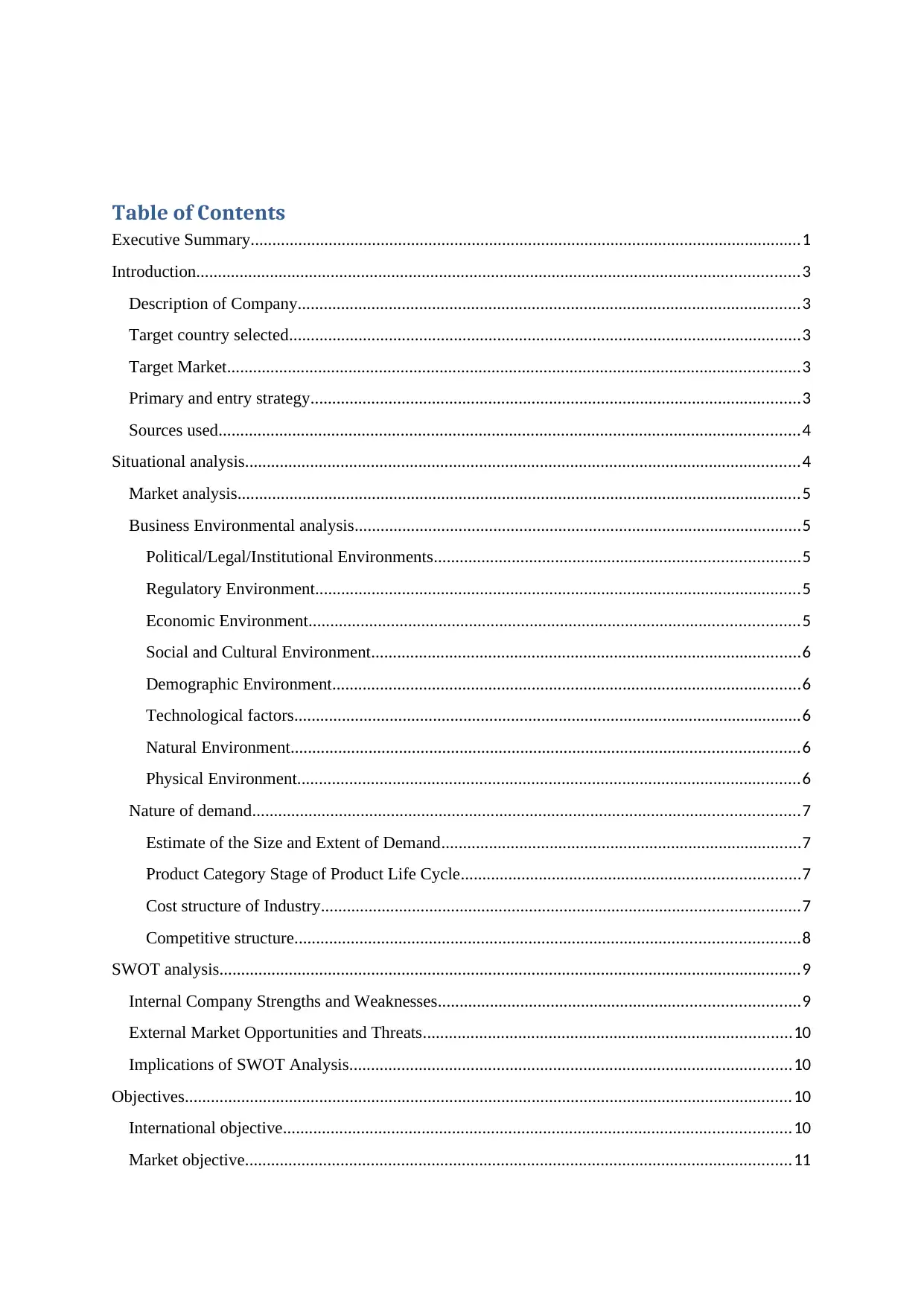
Table of Contents
Executive Summary...............................................................................................................................1
Introduction...........................................................................................................................................3
Description of Company....................................................................................................................3
Target country selected......................................................................................................................3
Target Market....................................................................................................................................3
Primary and entry strategy.................................................................................................................3
Sources used......................................................................................................................................4
Situational analysis................................................................................................................................4
Market analysis..................................................................................................................................5
Business Environmental analysis.......................................................................................................5
Political/Legal/Institutional Environments....................................................................................5
Regulatory Environment................................................................................................................5
Economic Environment.................................................................................................................5
Social and Cultural Environment...................................................................................................6
Demographic Environment............................................................................................................6
Technological factors.....................................................................................................................6
Natural Environment.....................................................................................................................6
Physical Environment....................................................................................................................6
Nature of demand..............................................................................................................................7
Estimate of the Size and Extent of Demand...................................................................................7
Product Category Stage of Product Life Cycle..............................................................................7
Cost structure of Industry..............................................................................................................7
Competitive structure....................................................................................................................8
SWOT analysis......................................................................................................................................9
Internal Company Strengths and Weaknesses...................................................................................9
External Market Opportunities and Threats.....................................................................................10
Implications of SWOT Analysis......................................................................................................10
Objectives............................................................................................................................................10
International objective.....................................................................................................................10
Market objective..............................................................................................................................11
Executive Summary...............................................................................................................................1
Introduction...........................................................................................................................................3
Description of Company....................................................................................................................3
Target country selected......................................................................................................................3
Target Market....................................................................................................................................3
Primary and entry strategy.................................................................................................................3
Sources used......................................................................................................................................4
Situational analysis................................................................................................................................4
Market analysis..................................................................................................................................5
Business Environmental analysis.......................................................................................................5
Political/Legal/Institutional Environments....................................................................................5
Regulatory Environment................................................................................................................5
Economic Environment.................................................................................................................5
Social and Cultural Environment...................................................................................................6
Demographic Environment............................................................................................................6
Technological factors.....................................................................................................................6
Natural Environment.....................................................................................................................6
Physical Environment....................................................................................................................6
Nature of demand..............................................................................................................................7
Estimate of the Size and Extent of Demand...................................................................................7
Product Category Stage of Product Life Cycle..............................................................................7
Cost structure of Industry..............................................................................................................7
Competitive structure....................................................................................................................8
SWOT analysis......................................................................................................................................9
Internal Company Strengths and Weaknesses...................................................................................9
External Market Opportunities and Threats.....................................................................................10
Implications of SWOT Analysis......................................................................................................10
Objectives............................................................................................................................................10
International objective.....................................................................................................................10
Market objective..............................................................................................................................11
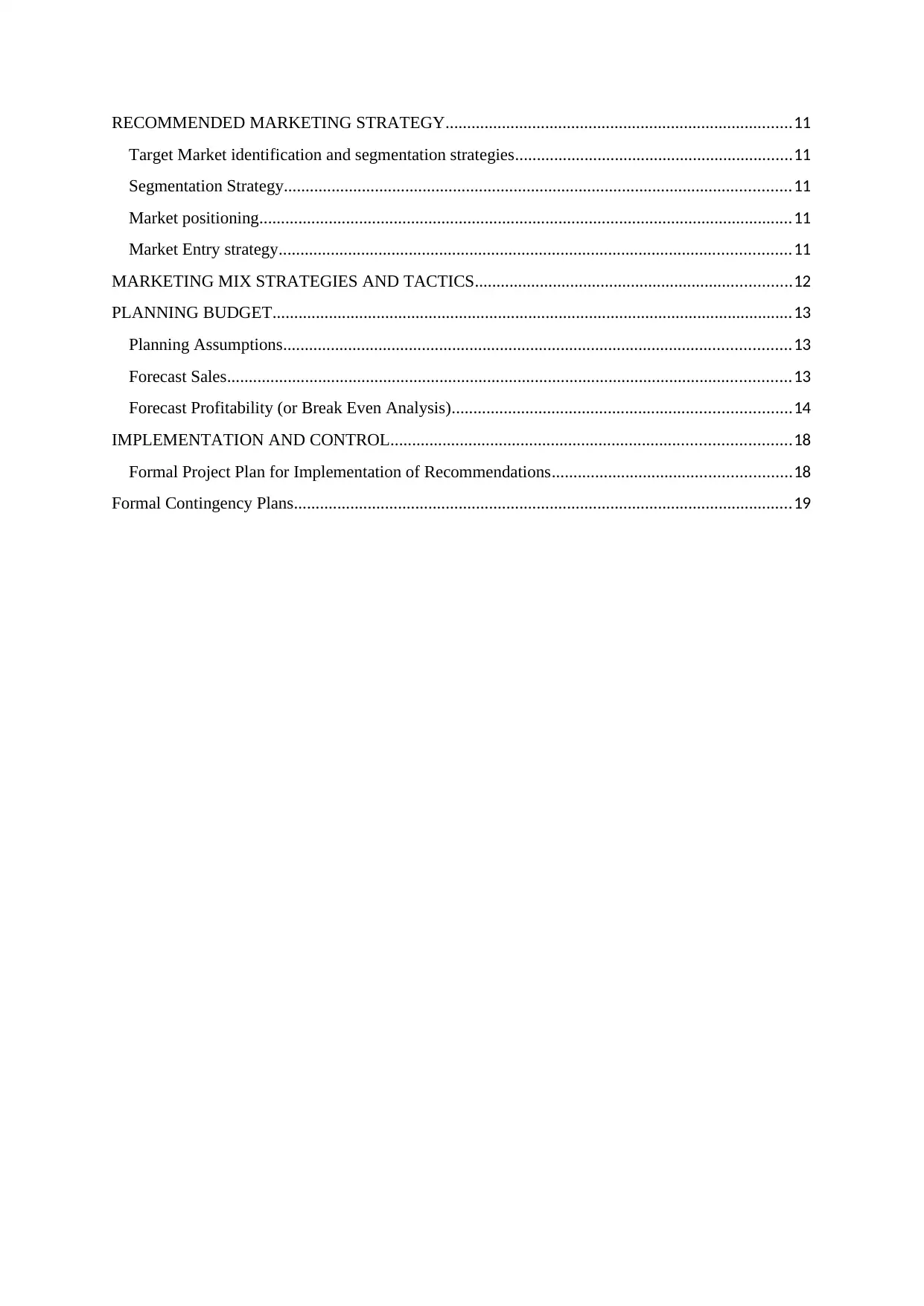
RECOMMENDED MARKETING STRATEGY................................................................................11
Target Market identification and segmentation strategies................................................................11
Segmentation Strategy.....................................................................................................................11
Market positioning...........................................................................................................................11
Market Entry strategy......................................................................................................................11
MARKETING MIX STRATEGIES AND TACTICS.........................................................................12
PLANNING BUDGET........................................................................................................................13
Planning Assumptions.....................................................................................................................13
Forecast Sales..................................................................................................................................13
Forecast Profitability (or Break Even Analysis)..............................................................................14
IMPLEMENTATION AND CONTROL............................................................................................18
Formal Project Plan for Implementation of Recommendations.......................................................18
Formal Contingency Plans...................................................................................................................19
Target Market identification and segmentation strategies................................................................11
Segmentation Strategy.....................................................................................................................11
Market positioning...........................................................................................................................11
Market Entry strategy......................................................................................................................11
MARKETING MIX STRATEGIES AND TACTICS.........................................................................12
PLANNING BUDGET........................................................................................................................13
Planning Assumptions.....................................................................................................................13
Forecast Sales..................................................................................................................................13
Forecast Profitability (or Break Even Analysis)..............................................................................14
IMPLEMENTATION AND CONTROL............................................................................................18
Formal Project Plan for Implementation of Recommendations.......................................................18
Formal Contingency Plans...................................................................................................................19
Secure Best Marks with AI Grader
Need help grading? Try our AI Grader for instant feedback on your assignments.

Introduction
Expanding business is very much required for the sustainable growth and effective
business strategies of the organization. It is analyzed that Wesfarmers could use the high
return of the clothing industry by setting up new outlets in Malaysia for selling cloths and
Jeans.
Description of Company
It is retail business organization which has been running its business on international level. It
is Australian conglomerate headquarter in Perth with interests predominantly in Australian
and New Zealand retail, chemicals, fertilisers, coal mining and industrial and safety products.
The total revenue of company is 6,844 billion AUD (2017) and share price of company is
currently traded at WES (ASX) A$ 49.45 -0.21 (-0.41%).
Target country selected
. It is analyzed that with the purchasing power of the people in Singapore, Wesfarmers could
easily offer high quality clothes to its clients irrespective of prices and costing of clothes in
market.
Target Market
With the changes in economic condition of the Singapore, people in Singapore are more
inclined towards the high quality fabrics and cloths in their wearing. The target market would
be clothing business industry which will assist organization to grab the potential clients and
increase its overall sales.
Primary and entry strategy
The primary and entry strategy of Wesfarmers could be to enter into Joint venture strategic
alliance with other organization which will assist company to comply with the all the
applicable rules and regulations in new Singapore market (Bocken,. de Pauw, Bakker, . and
van der Grinten, 2016).
Expanding business is very much required for the sustainable growth and effective
business strategies of the organization. It is analyzed that Wesfarmers could use the high
return of the clothing industry by setting up new outlets in Malaysia for selling cloths and
Jeans.
Description of Company
It is retail business organization which has been running its business on international level. It
is Australian conglomerate headquarter in Perth with interests predominantly in Australian
and New Zealand retail, chemicals, fertilisers, coal mining and industrial and safety products.
The total revenue of company is 6,844 billion AUD (2017) and share price of company is
currently traded at WES (ASX) A$ 49.45 -0.21 (-0.41%).
Target country selected
. It is analyzed that with the purchasing power of the people in Singapore, Wesfarmers could
easily offer high quality clothes to its clients irrespective of prices and costing of clothes in
market.
Target Market
With the changes in economic condition of the Singapore, people in Singapore are more
inclined towards the high quality fabrics and cloths in their wearing. The target market would
be clothing business industry which will assist organization to grab the potential clients and
increase its overall sales.
Primary and entry strategy
The primary and entry strategy of Wesfarmers could be to enter into Joint venture strategic
alliance with other organization which will assist company to comply with the all the
applicable rules and regulations in new Singapore market (Bocken,. de Pauw, Bakker, . and
van der Grinten, 2016).
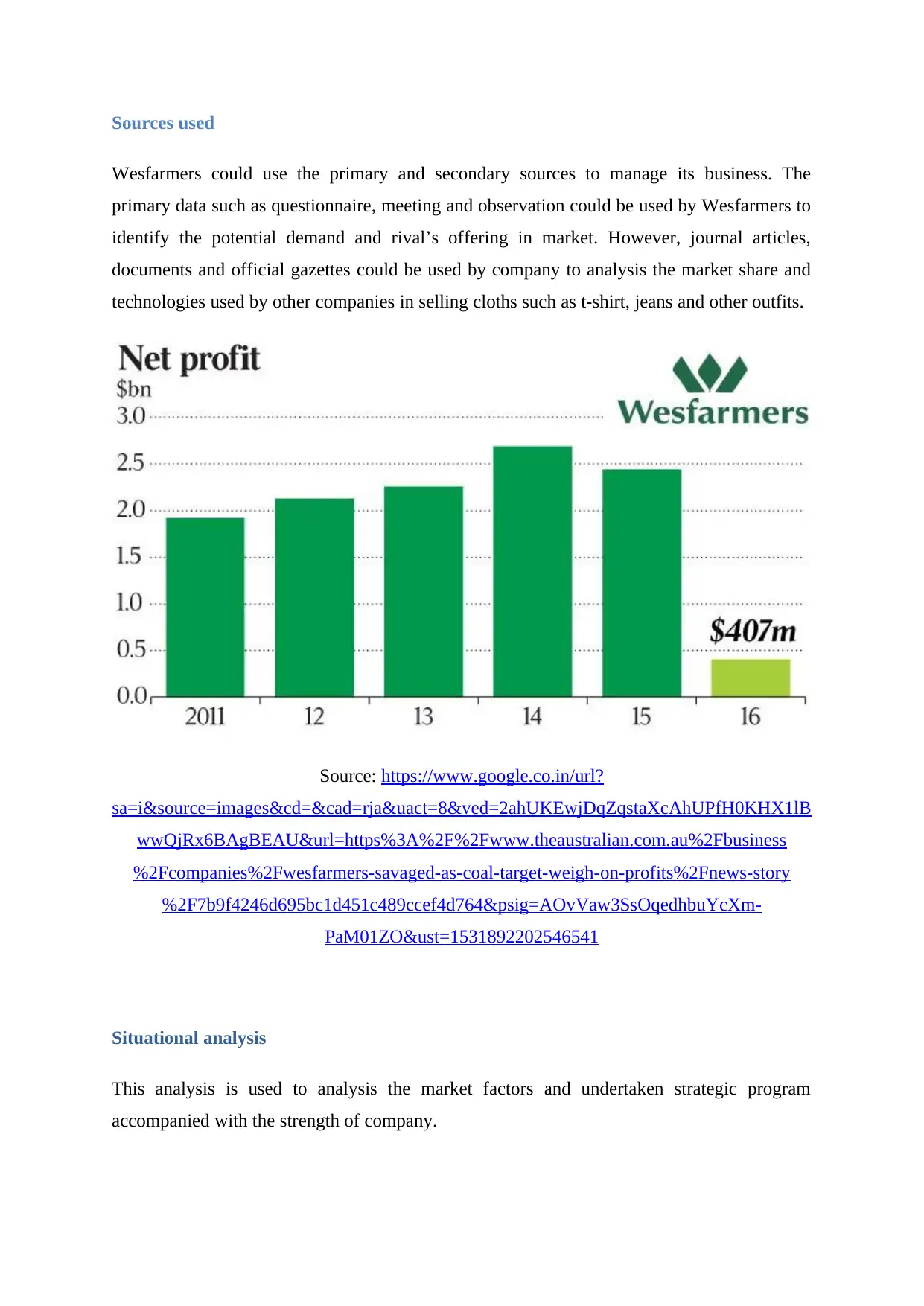
Sources used
Wesfarmers could use the primary and secondary sources to manage its business. The
primary data such as questionnaire, meeting and observation could be used by Wesfarmers to
identify the potential demand and rival’s offering in market. However, journal articles,
documents and official gazettes could be used by company to analysis the market share and
technologies used by other companies in selling cloths such as t-shirt, jeans and other outfits.
Source: https://www.google.co.in/url?
sa=i&source=images&cd=&cad=rja&uact=8&ved=2ahUKEwjDqZqstaXcAhUPfH0KHX1lB
wwQjRx6BAgBEAU&url=https%3A%2F%2Fwww.theaustralian.com.au%2Fbusiness
%2Fcompanies%2Fwesfarmers-savaged-as-coal-target-weigh-on-profits%2Fnews-story
%2F7b9f4246d695bc1d451c489ccef4d764&psig=AOvVaw3SsOqedhbuYcXm-
PaM01ZO&ust=1531892202546541
Situational analysis
This analysis is used to analysis the market factors and undertaken strategic program
accompanied with the strength of company.
Wesfarmers could use the primary and secondary sources to manage its business. The
primary data such as questionnaire, meeting and observation could be used by Wesfarmers to
identify the potential demand and rival’s offering in market. However, journal articles,
documents and official gazettes could be used by company to analysis the market share and
technologies used by other companies in selling cloths such as t-shirt, jeans and other outfits.
Source: https://www.google.co.in/url?
sa=i&source=images&cd=&cad=rja&uact=8&ved=2ahUKEwjDqZqstaXcAhUPfH0KHX1lB
wwQjRx6BAgBEAU&url=https%3A%2F%2Fwww.theaustralian.com.au%2Fbusiness
%2Fcompanies%2Fwesfarmers-savaged-as-coal-target-weigh-on-profits%2Fnews-story
%2F7b9f4246d695bc1d451c489ccef4d764&psig=AOvVaw3SsOqedhbuYcXm-
PaM01ZO&ust=1531892202546541
Situational analysis
This analysis is used to analysis the market factors and undertaken strategic program
accompanied with the strength of company.
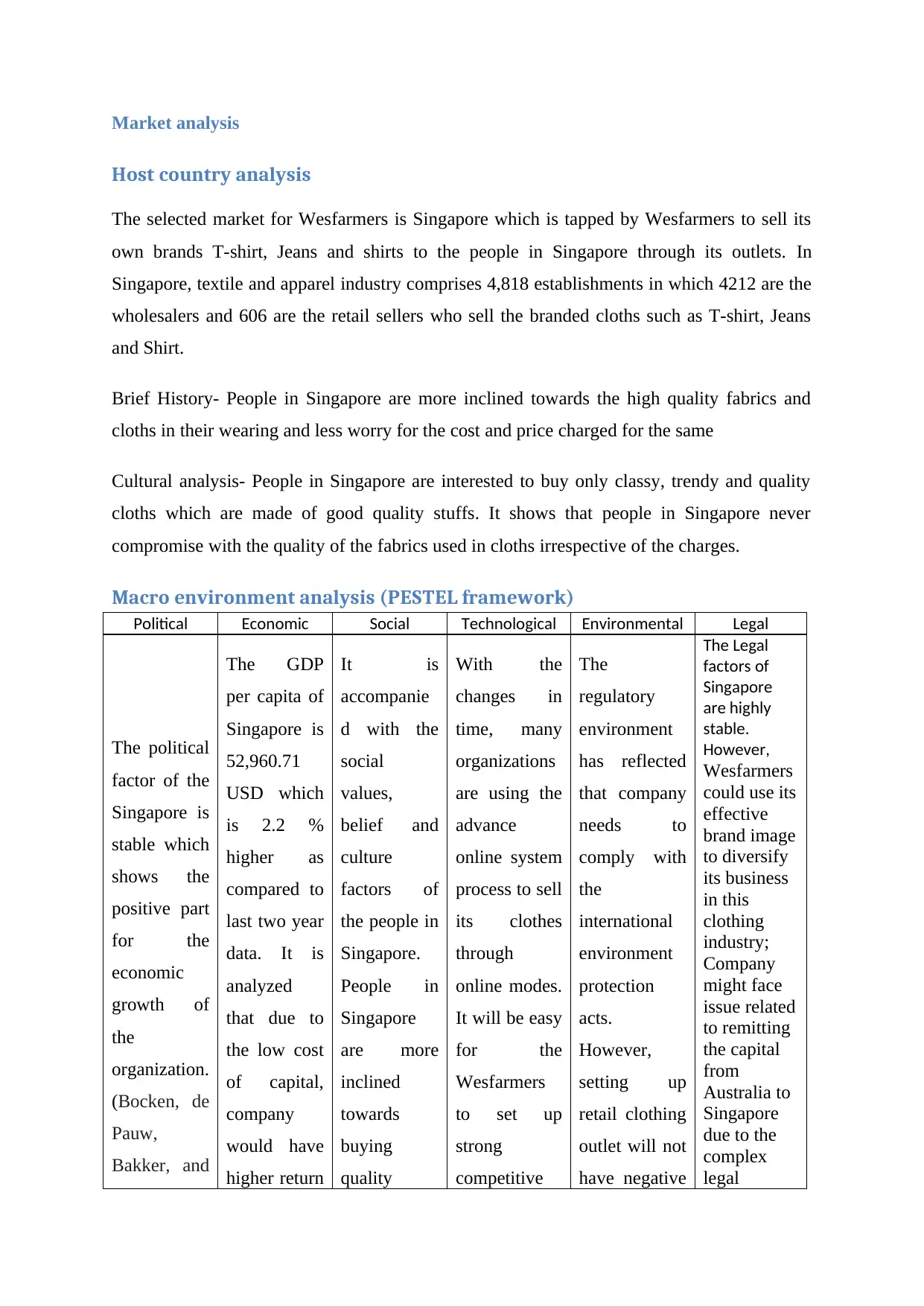
Market analysis
Host country analysis
The selected market for Wesfarmers is Singapore which is tapped by Wesfarmers to sell its
own brands T-shirt, Jeans and shirts to the people in Singapore through its outlets. In
Singapore, textile and apparel industry comprises 4,818 establishments in which 4212 are the
wholesalers and 606 are the retail sellers who sell the branded cloths such as T-shirt, Jeans
and Shirt.
Brief History- People in Singapore are more inclined towards the high quality fabrics and
cloths in their wearing and less worry for the cost and price charged for the same
Cultural analysis- People in Singapore are interested to buy only classy, trendy and quality
cloths which are made of good quality stuffs. It shows that people in Singapore never
compromise with the quality of the fabrics used in cloths irrespective of the charges.
Macro environment analysis (PESTEL framework)
Political Economic Social Technological Environmental Legal
The political
factor of the
Singapore is
stable which
shows the
positive part
for the
economic
growth of
the
organization.
(Bocken, de
Pauw,
Bakker, and
The GDP
per capita of
Singapore is
52,960.71
USD which
is 2.2 %
higher as
compared to
last two year
data. It is
analyzed
that due to
the low cost
of capital,
company
would have
higher return
It is
accompanie
d with the
social
values,
belief and
culture
factors of
the people in
Singapore.
People in
Singapore
are more
inclined
towards
buying
quality
With the
changes in
time, many
organizations
are using the
advance
online system
process to sell
its clothes
through
online modes.
It will be easy
for the
Wesfarmers
to set up
strong
competitive
The
regulatory
environment
has reflected
that company
needs to
comply with
the
international
environment
protection
acts.
However,
setting up
retail clothing
outlet will not
have negative
The Legal
factors of
Singapore
are highly
stable.
However,
Wesfarmers
could use its
effective
brand image
to diversify
its business
in this
clothing
industry;
Company
might face
issue related
to remitting
the capital
from
Australia to
Singapore
due to the
complex
legal
Host country analysis
The selected market for Wesfarmers is Singapore which is tapped by Wesfarmers to sell its
own brands T-shirt, Jeans and shirts to the people in Singapore through its outlets. In
Singapore, textile and apparel industry comprises 4,818 establishments in which 4212 are the
wholesalers and 606 are the retail sellers who sell the branded cloths such as T-shirt, Jeans
and Shirt.
Brief History- People in Singapore are more inclined towards the high quality fabrics and
cloths in their wearing and less worry for the cost and price charged for the same
Cultural analysis- People in Singapore are interested to buy only classy, trendy and quality
cloths which are made of good quality stuffs. It shows that people in Singapore never
compromise with the quality of the fabrics used in cloths irrespective of the charges.
Macro environment analysis (PESTEL framework)
Political Economic Social Technological Environmental Legal
The political
factor of the
Singapore is
stable which
shows the
positive part
for the
economic
growth of
the
organization.
(Bocken, de
Pauw,
Bakker, and
The GDP
per capita of
Singapore is
52,960.71
USD which
is 2.2 %
higher as
compared to
last two year
data. It is
analyzed
that due to
the low cost
of capital,
company
would have
higher return
It is
accompanie
d with the
social
values,
belief and
culture
factors of
the people in
Singapore.
People in
Singapore
are more
inclined
towards
buying
quality
With the
changes in
time, many
organizations
are using the
advance
online system
process to sell
its clothes
through
online modes.
It will be easy
for the
Wesfarmers
to set up
strong
competitive
The
regulatory
environment
has reflected
that company
needs to
comply with
the
international
environment
protection
acts.
However,
setting up
retail clothing
outlet will not
have negative
The Legal
factors of
Singapore
are highly
stable.
However,
Wesfarmers
could use its
effective
brand image
to diversify
its business
in this
clothing
industry;
Company
might face
issue related
to remitting
the capital
from
Australia to
Singapore
due to the
complex
legal
Paraphrase This Document
Need a fresh take? Get an instant paraphrase of this document with our AI Paraphraser
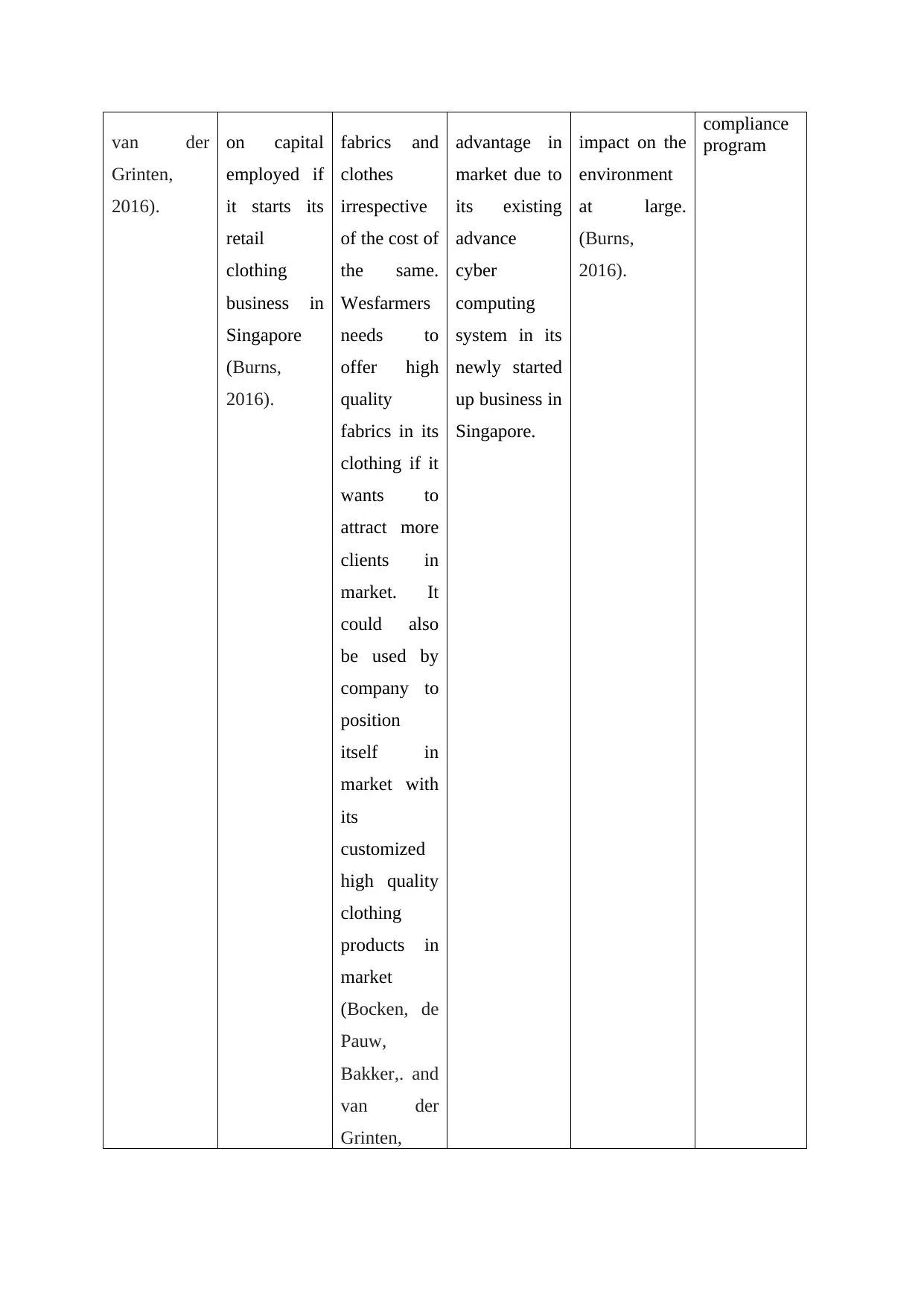
van der
Grinten,
2016).
on capital
employed if
it starts its
retail
clothing
business in
Singapore
(Burns,
2016).
fabrics and
clothes
irrespective
of the cost of
the same.
Wesfarmers
needs to
offer high
quality
fabrics in its
clothing if it
wants to
attract more
clients in
market. It
could also
be used by
company to
position
itself in
market with
its
customized
high quality
clothing
products in
market
(Bocken, de
Pauw,
Bakker,. and
van der
Grinten,
advantage in
market due to
its existing
advance
cyber
computing
system in its
newly started
up business in
Singapore.
impact on the
environment
at large.
(Burns,
2016).
compliance
program
Grinten,
2016).
on capital
employed if
it starts its
retail
clothing
business in
Singapore
(Burns,
2016).
fabrics and
clothes
irrespective
of the cost of
the same.
Wesfarmers
needs to
offer high
quality
fabrics in its
clothing if it
wants to
attract more
clients in
market. It
could also
be used by
company to
position
itself in
market with
its
customized
high quality
clothing
products in
market
(Bocken, de
Pauw,
Bakker,. and
van der
Grinten,
advantage in
market due to
its existing
advance
cyber
computing
system in its
newly started
up business in
Singapore.
impact on the
environment
at large.
(Burns,
2016).
compliance
program
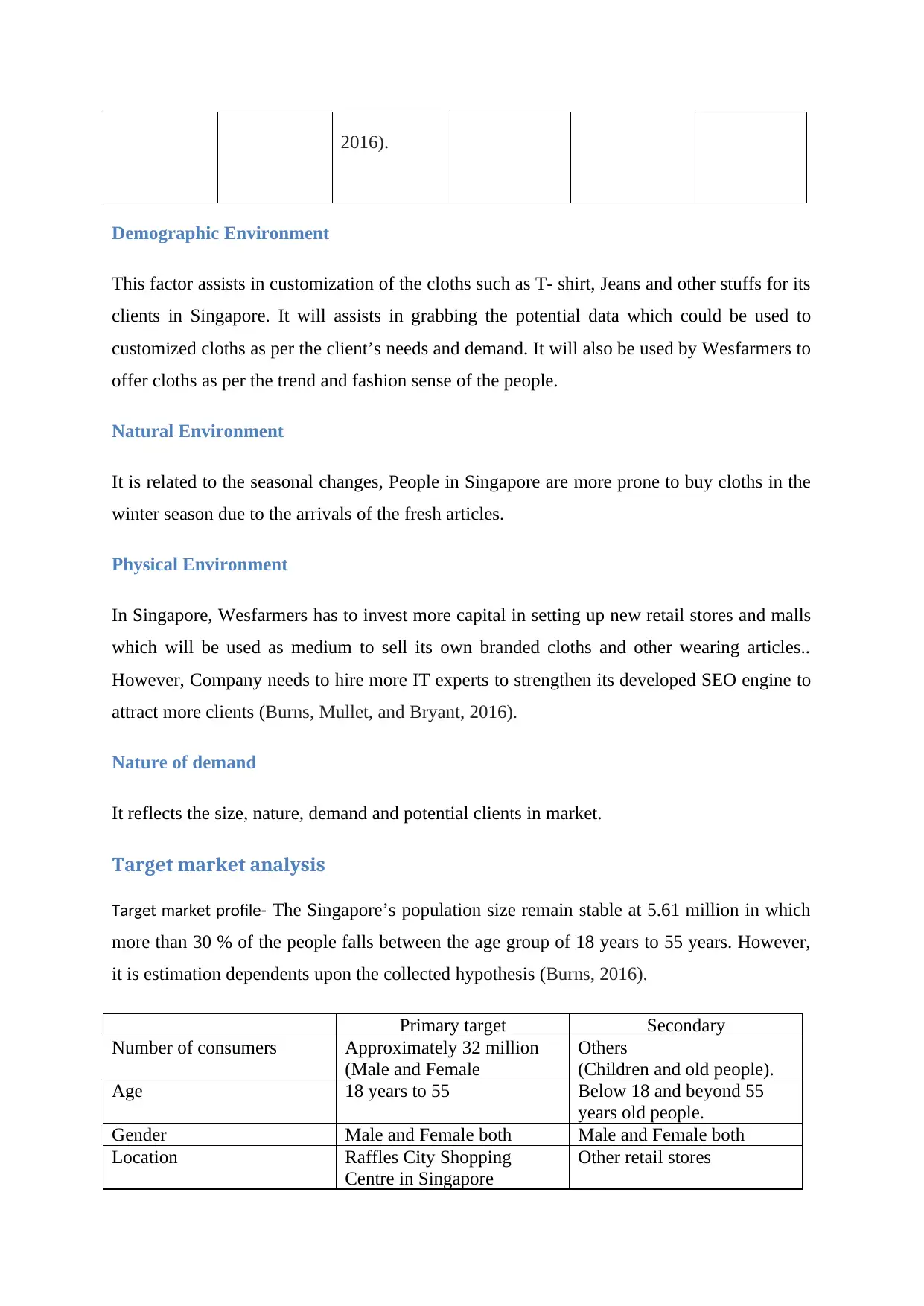
2016).
Demographic Environment
This factor assists in customization of the cloths such as T- shirt, Jeans and other stuffs for its
clients in Singapore. It will assists in grabbing the potential data which could be used to
customized cloths as per the client’s needs and demand. It will also be used by Wesfarmers to
offer cloths as per the trend and fashion sense of the people.
Natural Environment
It is related to the seasonal changes, People in Singapore are more prone to buy cloths in the
winter season due to the arrivals of the fresh articles.
Physical Environment
In Singapore, Wesfarmers has to invest more capital in setting up new retail stores and malls
which will be used as medium to sell its own branded cloths and other wearing articles..
However, Company needs to hire more IT experts to strengthen its developed SEO engine to
attract more clients (Burns, Mullet, and Bryant, 2016).
Nature of demand
It reflects the size, nature, demand and potential clients in market.
Target market analysis
Target market profile- The Singapore’s population size remain stable at 5.61 million in which
more than 30 % of the people falls between the age group of 18 years to 55 years. However,
it is estimation dependents upon the collected hypothesis (Burns, 2016).
Primary target Secondary
Number of consumers Approximately 32 million
(Male and Female
Others
(Children and old people).
Age 18 years to 55 Below 18 and beyond 55
years old people.
Gender Male and Female both Male and Female both
Location Raffles City Shopping
Centre in Singapore
Other retail stores
Demographic Environment
This factor assists in customization of the cloths such as T- shirt, Jeans and other stuffs for its
clients in Singapore. It will assists in grabbing the potential data which could be used to
customized cloths as per the client’s needs and demand. It will also be used by Wesfarmers to
offer cloths as per the trend and fashion sense of the people.
Natural Environment
It is related to the seasonal changes, People in Singapore are more prone to buy cloths in the
winter season due to the arrivals of the fresh articles.
Physical Environment
In Singapore, Wesfarmers has to invest more capital in setting up new retail stores and malls
which will be used as medium to sell its own branded cloths and other wearing articles..
However, Company needs to hire more IT experts to strengthen its developed SEO engine to
attract more clients (Burns, Mullet, and Bryant, 2016).
Nature of demand
It reflects the size, nature, demand and potential clients in market.
Target market analysis
Target market profile- The Singapore’s population size remain stable at 5.61 million in which
more than 30 % of the people falls between the age group of 18 years to 55 years. However,
it is estimation dependents upon the collected hypothesis (Burns, 2016).
Primary target Secondary
Number of consumers Approximately 32 million
(Male and Female
Others
(Children and old people).
Age 18 years to 55 Below 18 and beyond 55
years old people.
Gender Male and Female both Male and Female both
Location Raffles City Shopping
Centre in Singapore
Other retail stores
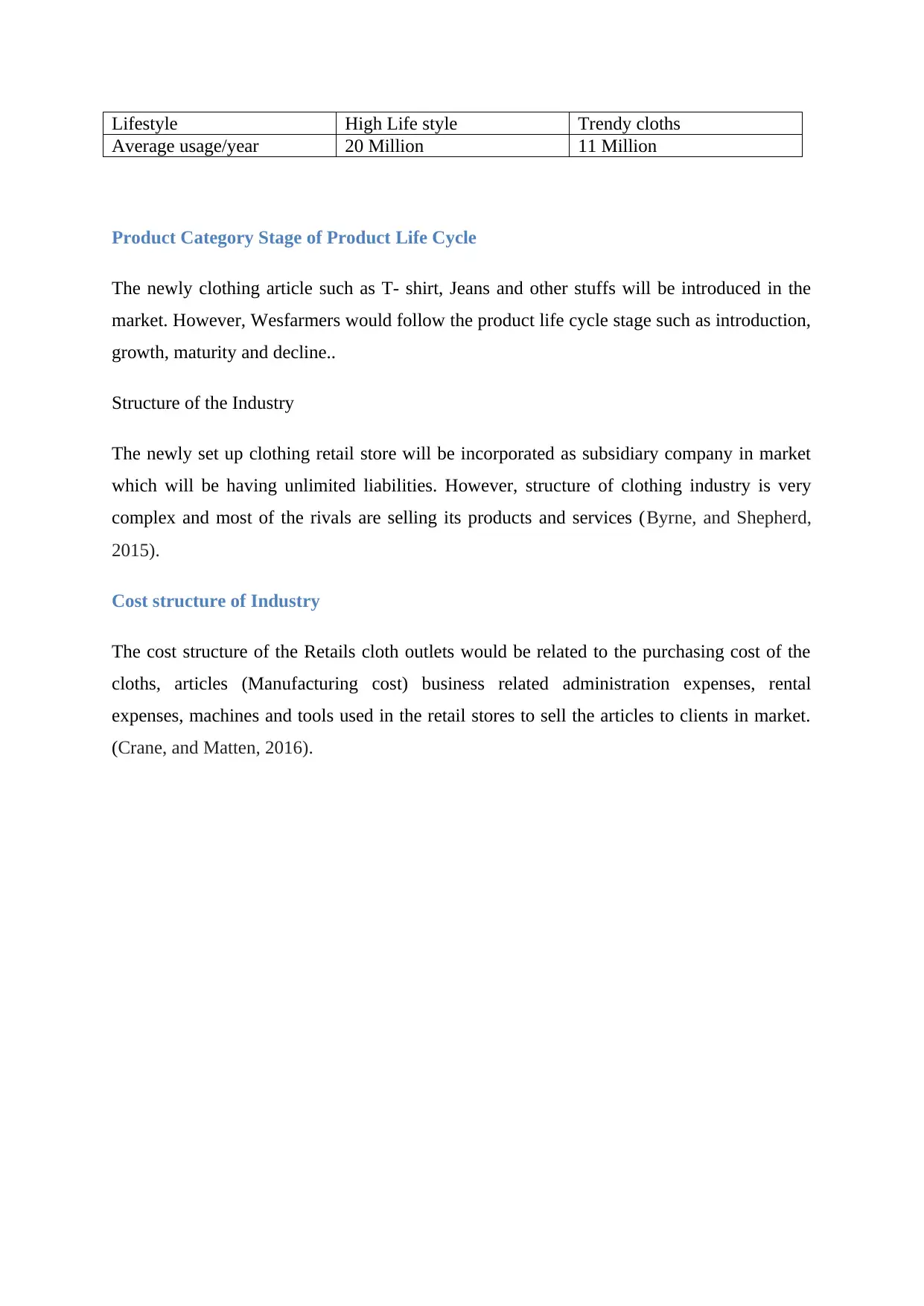
Lifestyle High Life style Trendy cloths
Average usage/year 20 Million 11 Million
Product Category Stage of Product Life Cycle
The newly clothing article such as T- shirt, Jeans and other stuffs will be introduced in the
market. However, Wesfarmers would follow the product life cycle stage such as introduction,
growth, maturity and decline..
Structure of the Industry
The newly set up clothing retail store will be incorporated as subsidiary company in market
which will be having unlimited liabilities. However, structure of clothing industry is very
complex and most of the rivals are selling its products and services (Byrne, and Shepherd,
2015).
Cost structure of Industry
The cost structure of the Retails cloth outlets would be related to the purchasing cost of the
cloths, articles (Manufacturing cost) business related administration expenses, rental
expenses, machines and tools used in the retail stores to sell the articles to clients in market.
(Crane, and Matten, 2016).
Average usage/year 20 Million 11 Million
Product Category Stage of Product Life Cycle
The newly clothing article such as T- shirt, Jeans and other stuffs will be introduced in the
market. However, Wesfarmers would follow the product life cycle stage such as introduction,
growth, maturity and decline..
Structure of the Industry
The newly set up clothing retail store will be incorporated as subsidiary company in market
which will be having unlimited liabilities. However, structure of clothing industry is very
complex and most of the rivals are selling its products and services (Byrne, and Shepherd,
2015).
Cost structure of Industry
The cost structure of the Retails cloth outlets would be related to the purchasing cost of the
cloths, articles (Manufacturing cost) business related administration expenses, rental
expenses, machines and tools used in the retail stores to sell the articles to clients in market.
(Crane, and Matten, 2016).
Secure Best Marks with AI Grader
Need help grading? Try our AI Grader for instant feedback on your assignments.
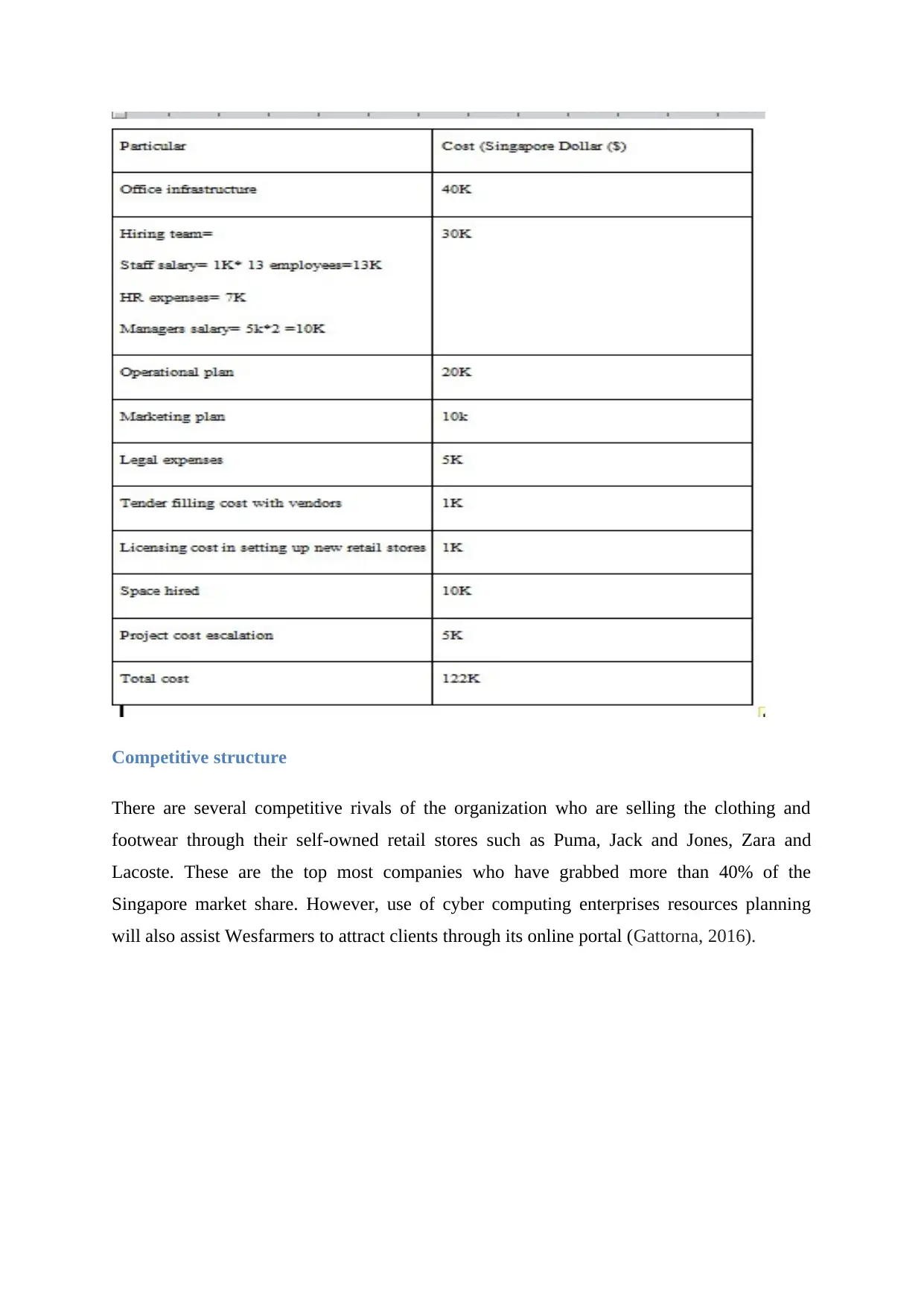
Competitive structure
There are several competitive rivals of the organization who are selling the clothing and
footwear through their self-owned retail stores such as Puma, Jack and Jones, Zara and
Lacoste. These are the top most companies who have grabbed more than 40% of the
Singapore market share. However, use of cyber computing enterprises resources planning
will also assist Wesfarmers to attract clients through its online portal (Gattorna, 2016).
There are several competitive rivals of the organization who are selling the clothing and
footwear through their self-owned retail stores such as Puma, Jack and Jones, Zara and
Lacoste. These are the top most companies who have grabbed more than 40% of the
Singapore market share. However, use of cyber computing enterprises resources planning
will also assist Wesfarmers to attract clients through its online portal (Gattorna, 2016).
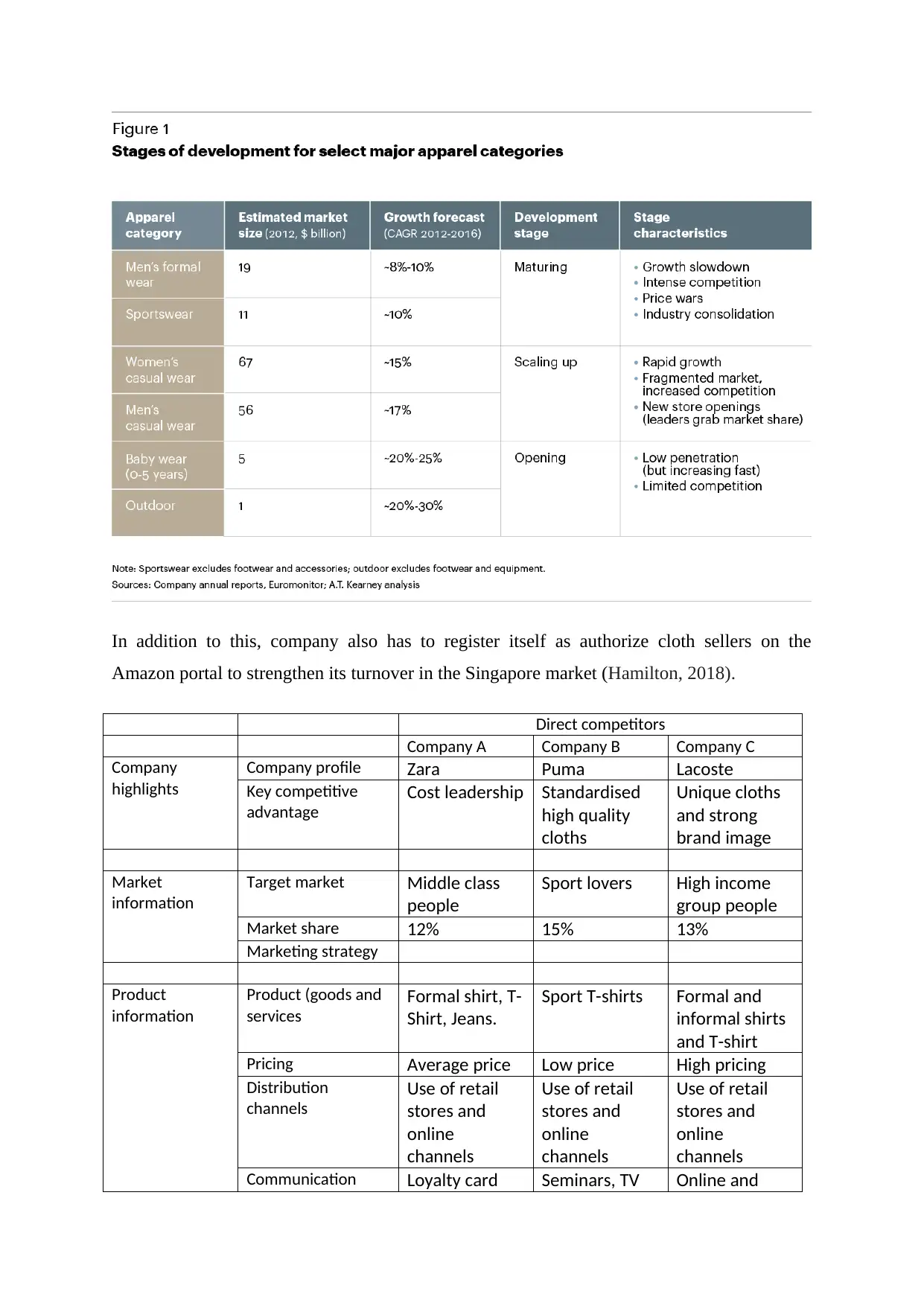
In addition to this, company also has to register itself as authorize cloth sellers on the
Amazon portal to strengthen its turnover in the Singapore market (Hamilton, 2018).
Direct competitors
Company A Company B Company C
Company
highlights
Company profile Zara Puma Lacoste
Key competitive
advantage
Cost leadership Standardised
high quality
cloths
Unique cloths
and strong
brand image
Market
information
Target market Middle class
people
Sport lovers High income
group people
Market share 12% 15% 13%
Marketing strategy
Product
information
Product (goods and
services
Formal shirt, T-
Shirt, Jeans.
Sport T-shirts Formal and
informal shirts
and T-shirt
Pricing Average price Low price High pricing
Distribution
channels
Use of retail
stores and
online
channels
Use of retail
stores and
online
channels
Use of retail
stores and
online
channels
Communication Loyalty card Seminars, TV Online and
Amazon portal to strengthen its turnover in the Singapore market (Hamilton, 2018).
Direct competitors
Company A Company B Company C
Company
highlights
Company profile Zara Puma Lacoste
Key competitive
advantage
Cost leadership Standardised
high quality
cloths
Unique cloths
and strong
brand image
Market
information
Target market Middle class
people
Sport lovers High income
group people
Market share 12% 15% 13%
Marketing strategy
Product
information
Product (goods and
services
Formal shirt, T-
Shirt, Jeans.
Sport T-shirts Formal and
informal shirts
and T-shirt
Pricing Average price Low price High pricing
Distribution
channels
Use of retail
stores and
online
channels
Use of retail
stores and
online
channels
Use of retail
stores and
online
channels
Communication Loyalty card Seminars, TV Online and
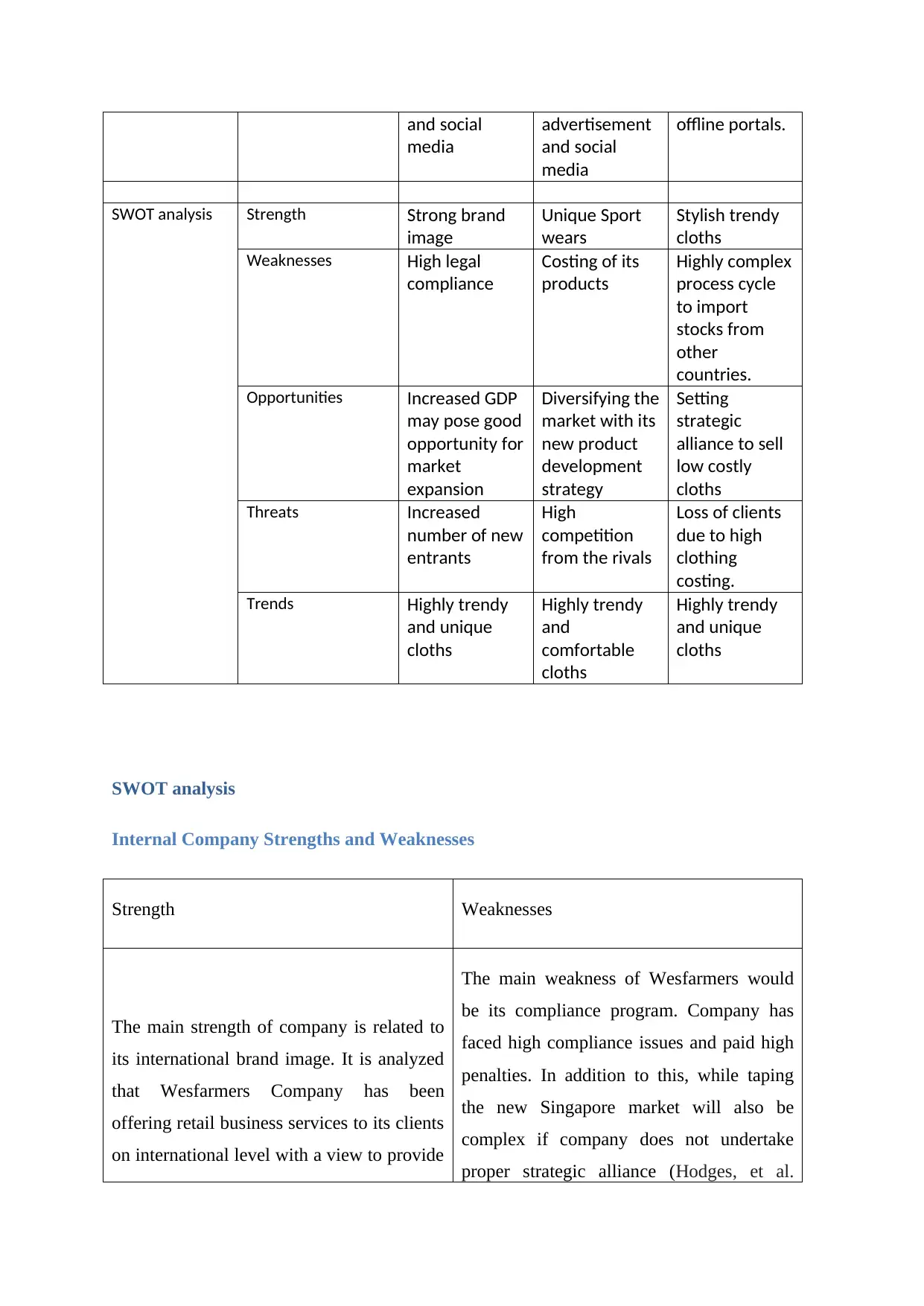
and social
media
advertisement
and social
media
offline portals.
SWOT analysis Strength Strong brand
image
Unique Sport
wears
Stylish trendy
cloths
Weaknesses High legal
compliance
Costing of its
products
Highly complex
process cycle
to import
stocks from
other
countries.
Opportunities Increased GDP
may pose good
opportunity for
market
expansion
Diversifying the
market with its
new product
development
strategy
Setting
strategic
alliance to sell
low costly
cloths
Threats Increased
number of new
entrants
High
competition
from the rivals
Loss of clients
due to high
clothing
costing.
Trends Highly trendy
and unique
cloths
Highly trendy
and
comfortable
cloths
Highly trendy
and unique
cloths
SWOT analysis
Internal Company Strengths and Weaknesses
Strength Weaknesses
The main strength of company is related to
its international brand image. It is analyzed
that Wesfarmers Company has been
offering retail business services to its clients
on international level with a view to provide
The main weakness of Wesfarmers would
be its compliance program. Company has
faced high compliance issues and paid high
penalties. In addition to this, while taping
the new Singapore market will also be
complex if company does not undertake
proper strategic alliance (Hodges, et al.
media
advertisement
and social
media
offline portals.
SWOT analysis Strength Strong brand
image
Unique Sport
wears
Stylish trendy
cloths
Weaknesses High legal
compliance
Costing of its
products
Highly complex
process cycle
to import
stocks from
other
countries.
Opportunities Increased GDP
may pose good
opportunity for
market
expansion
Diversifying the
market with its
new product
development
strategy
Setting
strategic
alliance to sell
low costly
cloths
Threats Increased
number of new
entrants
High
competition
from the rivals
Loss of clients
due to high
clothing
costing.
Trends Highly trendy
and unique
cloths
Highly trendy
and
comfortable
cloths
Highly trendy
and unique
cloths
SWOT analysis
Internal Company Strengths and Weaknesses
Strength Weaknesses
The main strength of company is related to
its international brand image. It is analyzed
that Wesfarmers Company has been
offering retail business services to its clients
on international level with a view to provide
The main weakness of Wesfarmers would
be its compliance program. Company has
faced high compliance issues and paid high
penalties. In addition to this, while taping
the new Singapore market will also be
complex if company does not undertake
proper strategic alliance (Hodges, et al.
Paraphrase This Document
Need a fresh take? Get an instant paraphrase of this document with our AI Paraphraser
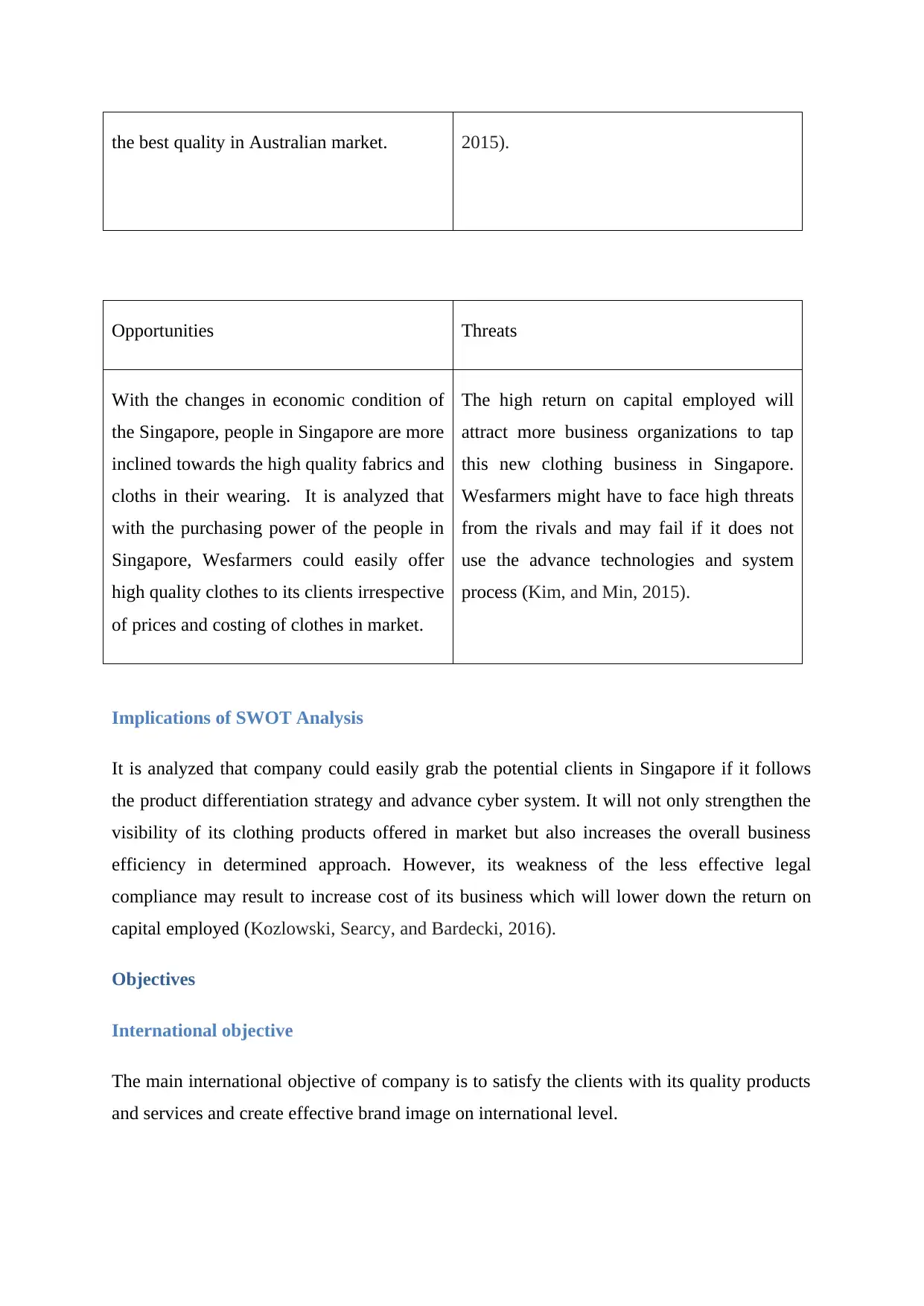
the best quality in Australian market. 2015).
Opportunities Threats
With the changes in economic condition of
the Singapore, people in Singapore are more
inclined towards the high quality fabrics and
cloths in their wearing. It is analyzed that
with the purchasing power of the people in
Singapore, Wesfarmers could easily offer
high quality clothes to its clients irrespective
of prices and costing of clothes in market.
The high return on capital employed will
attract more business organizations to tap
this new clothing business in Singapore.
Wesfarmers might have to face high threats
from the rivals and may fail if it does not
use the advance technologies and system
process (Kim, and Min, 2015).
Implications of SWOT Analysis
It is analyzed that company could easily grab the potential clients in Singapore if it follows
the product differentiation strategy and advance cyber system. It will not only strengthen the
visibility of its clothing products offered in market but also increases the overall business
efficiency in determined approach. However, its weakness of the less effective legal
compliance may result to increase cost of its business which will lower down the return on
capital employed (Kozlowski, Searcy, and Bardecki, 2016).
Objectives
International objective
The main international objective of company is to satisfy the clients with its quality products
and services and create effective brand image on international level.
Opportunities Threats
With the changes in economic condition of
the Singapore, people in Singapore are more
inclined towards the high quality fabrics and
cloths in their wearing. It is analyzed that
with the purchasing power of the people in
Singapore, Wesfarmers could easily offer
high quality clothes to its clients irrespective
of prices and costing of clothes in market.
The high return on capital employed will
attract more business organizations to tap
this new clothing business in Singapore.
Wesfarmers might have to face high threats
from the rivals and may fail if it does not
use the advance technologies and system
process (Kim, and Min, 2015).
Implications of SWOT Analysis
It is analyzed that company could easily grab the potential clients in Singapore if it follows
the product differentiation strategy and advance cyber system. It will not only strengthen the
visibility of its clothing products offered in market but also increases the overall business
efficiency in determined approach. However, its weakness of the less effective legal
compliance may result to increase cost of its business which will lower down the return on
capital employed (Kozlowski, Searcy, and Bardecki, 2016).
Objectives
International objective
The main international objective of company is to satisfy the clients with its quality products
and services and create effective brand image on international level.
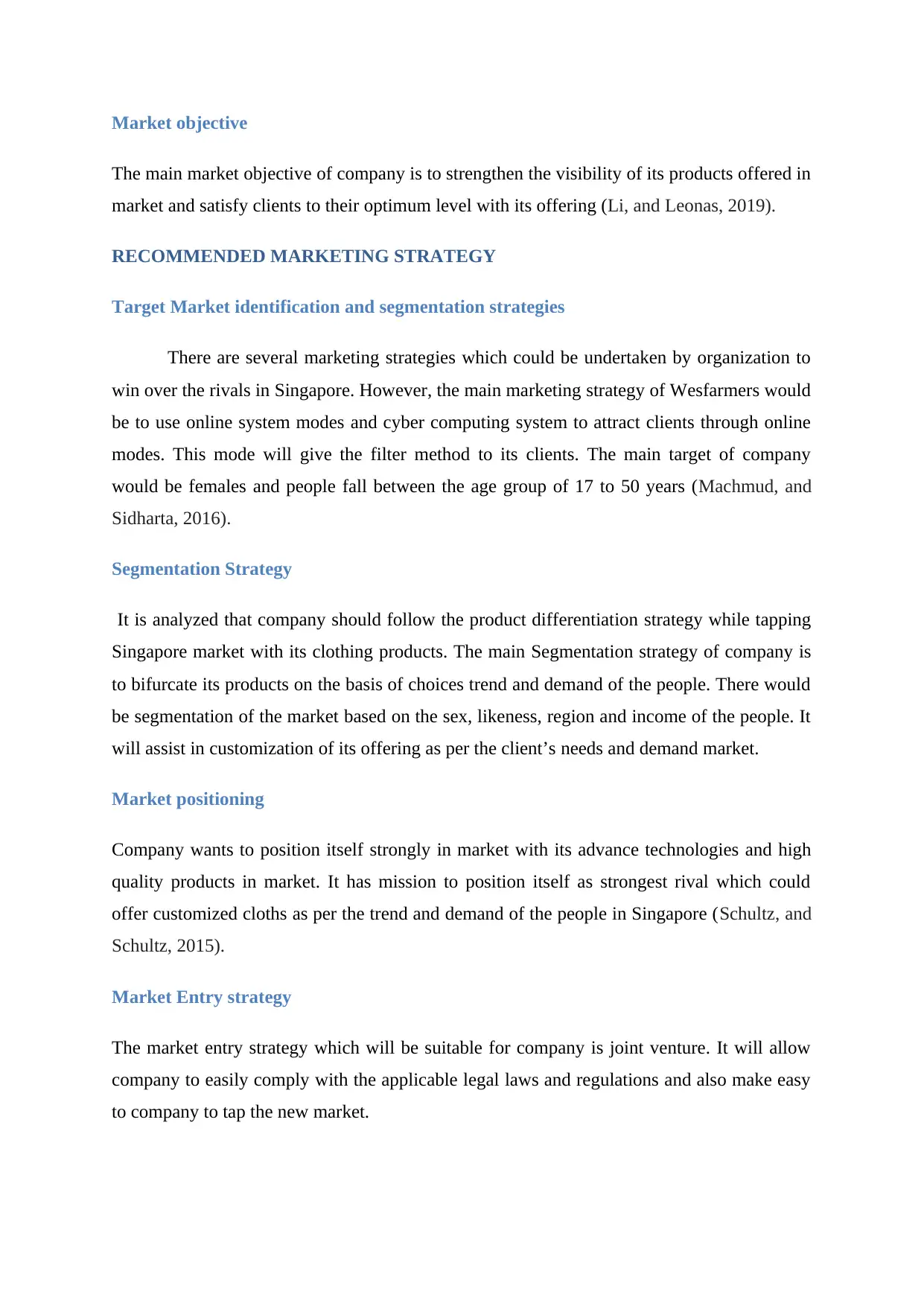
Market objective
The main market objective of company is to strengthen the visibility of its products offered in
market and satisfy clients to their optimum level with its offering (Li, and Leonas, 2019).
RECOMMENDED MARKETING STRATEGY
Target Market identification and segmentation strategies
There are several marketing strategies which could be undertaken by organization to
win over the rivals in Singapore. However, the main marketing strategy of Wesfarmers would
be to use online system modes and cyber computing system to attract clients through online
modes. This mode will give the filter method to its clients. The main target of company
would be females and people fall between the age group of 17 to 50 years (Machmud, and
Sidharta, 2016).
Segmentation Strategy
It is analyzed that company should follow the product differentiation strategy while tapping
Singapore market with its clothing products. The main Segmentation strategy of company is
to bifurcate its products on the basis of choices trend and demand of the people. There would
be segmentation of the market based on the sex, likeness, region and income of the people. It
will assist in customization of its offering as per the client’s needs and demand market.
Market positioning
Company wants to position itself strongly in market with its advance technologies and high
quality products in market. It has mission to position itself as strongest rival which could
offer customized cloths as per the trend and demand of the people in Singapore (Schultz, and
Schultz, 2015).
Market Entry strategy
The market entry strategy which will be suitable for company is joint venture. It will allow
company to easily comply with the applicable legal laws and regulations and also make easy
to company to tap the new market.
The main market objective of company is to strengthen the visibility of its products offered in
market and satisfy clients to their optimum level with its offering (Li, and Leonas, 2019).
RECOMMENDED MARKETING STRATEGY
Target Market identification and segmentation strategies
There are several marketing strategies which could be undertaken by organization to
win over the rivals in Singapore. However, the main marketing strategy of Wesfarmers would
be to use online system modes and cyber computing system to attract clients through online
modes. This mode will give the filter method to its clients. The main target of company
would be females and people fall between the age group of 17 to 50 years (Machmud, and
Sidharta, 2016).
Segmentation Strategy
It is analyzed that company should follow the product differentiation strategy while tapping
Singapore market with its clothing products. The main Segmentation strategy of company is
to bifurcate its products on the basis of choices trend and demand of the people. There would
be segmentation of the market based on the sex, likeness, region and income of the people. It
will assist in customization of its offering as per the client’s needs and demand market.
Market positioning
Company wants to position itself strongly in market with its advance technologies and high
quality products in market. It has mission to position itself as strongest rival which could
offer customized cloths as per the trend and demand of the people in Singapore (Schultz, and
Schultz, 2015).
Market Entry strategy
The market entry strategy which will be suitable for company is joint venture. It will allow
company to easily comply with the applicable legal laws and regulations and also make easy
to company to tap the new market.
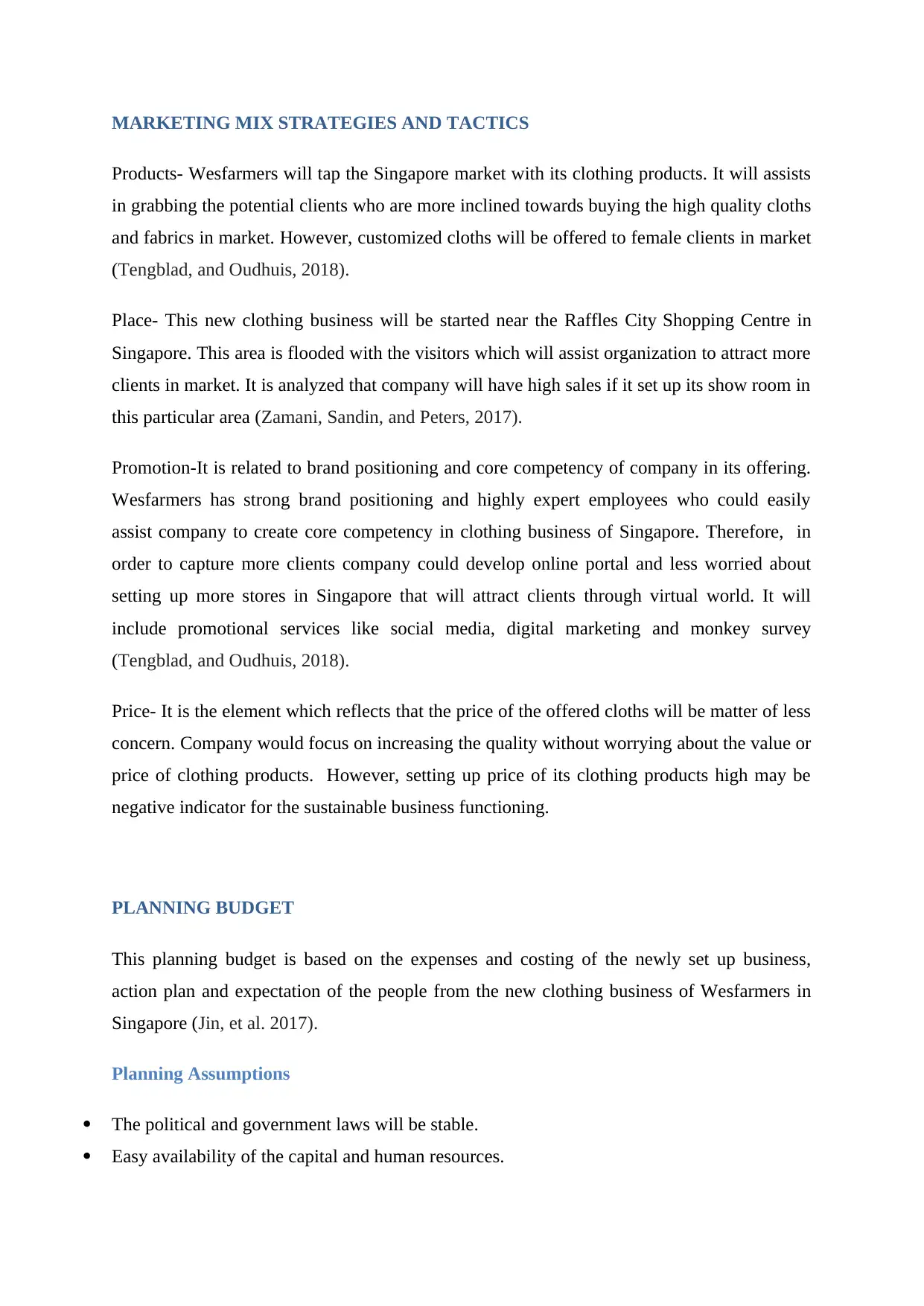
MARKETING MIX STRATEGIES AND TACTICS
Products- Wesfarmers will tap the Singapore market with its clothing products. It will assists
in grabbing the potential clients who are more inclined towards buying the high quality cloths
and fabrics in market. However, customized cloths will be offered to female clients in market
(Tengblad, and Oudhuis, 2018).
Place- This new clothing business will be started near the Raffles City Shopping Centre in
Singapore. This area is flooded with the visitors which will assist organization to attract more
clients in market. It is analyzed that company will have high sales if it set up its show room in
this particular area (Zamani, Sandin, and Peters, 2017).
Promotion-It is related to brand positioning and core competency of company in its offering.
Wesfarmers has strong brand positioning and highly expert employees who could easily
assist company to create core competency in clothing business of Singapore. Therefore, in
order to capture more clients company could develop online portal and less worried about
setting up more stores in Singapore that will attract clients through virtual world. It will
include promotional services like social media, digital marketing and monkey survey
(Tengblad, and Oudhuis, 2018).
Price- It is the element which reflects that the price of the offered cloths will be matter of less
concern. Company would focus on increasing the quality without worrying about the value or
price of clothing products. However, setting up price of its clothing products high may be
negative indicator for the sustainable business functioning.
PLANNING BUDGET
This planning budget is based on the expenses and costing of the newly set up business,
action plan and expectation of the people from the new clothing business of Wesfarmers in
Singapore (Jin, et al. 2017).
Planning Assumptions
The political and government laws will be stable.
Easy availability of the capital and human resources.
Products- Wesfarmers will tap the Singapore market with its clothing products. It will assists
in grabbing the potential clients who are more inclined towards buying the high quality cloths
and fabrics in market. However, customized cloths will be offered to female clients in market
(Tengblad, and Oudhuis, 2018).
Place- This new clothing business will be started near the Raffles City Shopping Centre in
Singapore. This area is flooded with the visitors which will assist organization to attract more
clients in market. It is analyzed that company will have high sales if it set up its show room in
this particular area (Zamani, Sandin, and Peters, 2017).
Promotion-It is related to brand positioning and core competency of company in its offering.
Wesfarmers has strong brand positioning and highly expert employees who could easily
assist company to create core competency in clothing business of Singapore. Therefore, in
order to capture more clients company could develop online portal and less worried about
setting up more stores in Singapore that will attract clients through virtual world. It will
include promotional services like social media, digital marketing and monkey survey
(Tengblad, and Oudhuis, 2018).
Price- It is the element which reflects that the price of the offered cloths will be matter of less
concern. Company would focus on increasing the quality without worrying about the value or
price of clothing products. However, setting up price of its clothing products high may be
negative indicator for the sustainable business functioning.
PLANNING BUDGET
This planning budget is based on the expenses and costing of the newly set up business,
action plan and expectation of the people from the new clothing business of Wesfarmers in
Singapore (Jin, et al. 2017).
Planning Assumptions
The political and government laws will be stable.
Easy availability of the capital and human resources.
Secure Best Marks with AI Grader
Need help grading? Try our AI Grader for instant feedback on your assignments.
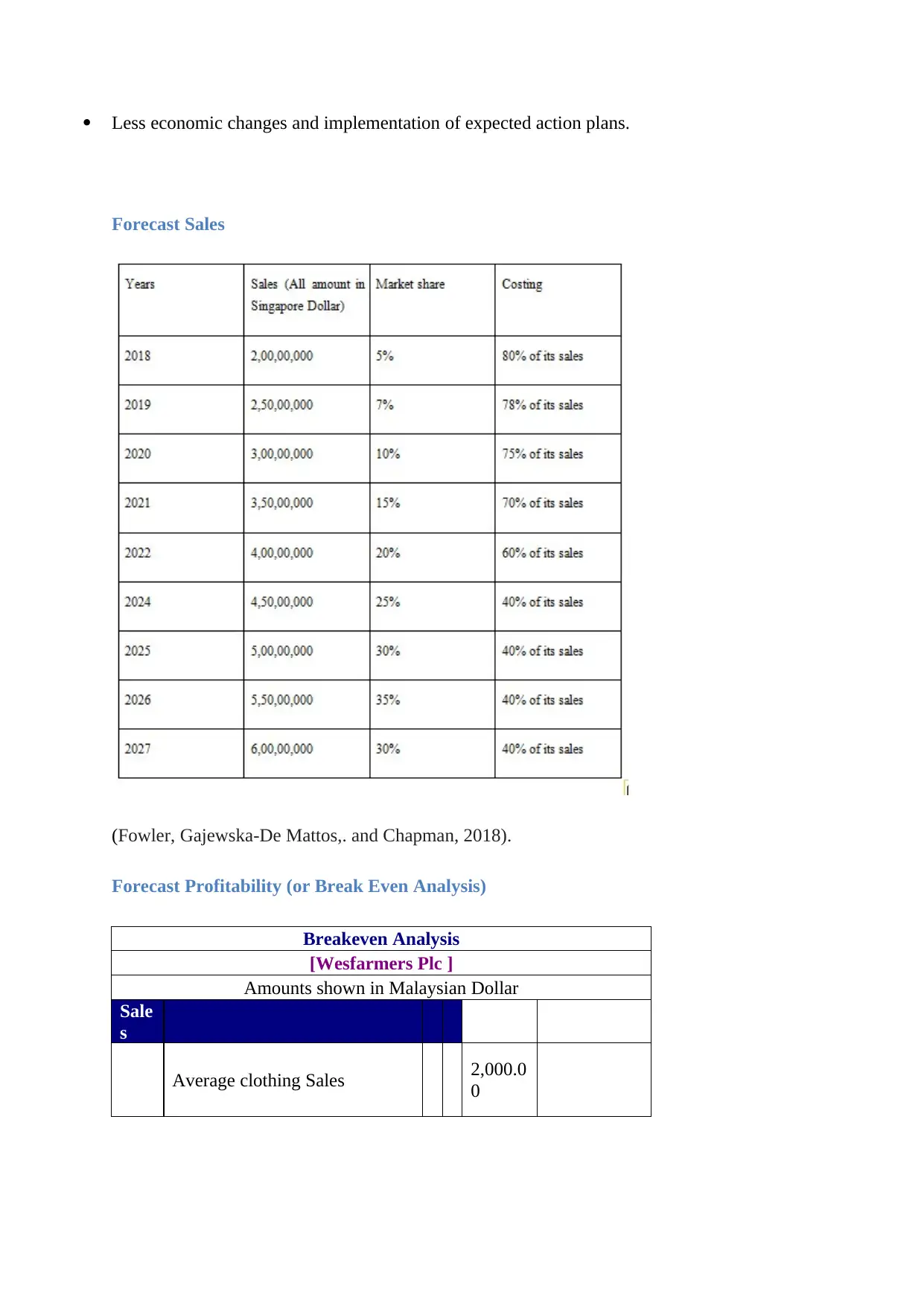
Less economic changes and implementation of expected action plans.
Forecast Sales
(Fowler, Gajewska-De Mattos,. and Chapman, 2018).
Forecast Profitability (or Break Even Analysis)
Breakeven Analysis
[Wesfarmers Plc ]
Amounts shown in Malaysian Dollar
Sale
s
Average clothing Sales 2,000.0
0
Forecast Sales
(Fowler, Gajewska-De Mattos,. and Chapman, 2018).
Forecast Profitability (or Break Even Analysis)
Breakeven Analysis
[Wesfarmers Plc ]
Amounts shown in Malaysian Dollar
Sale
s
Average clothing Sales 2,000.0
0
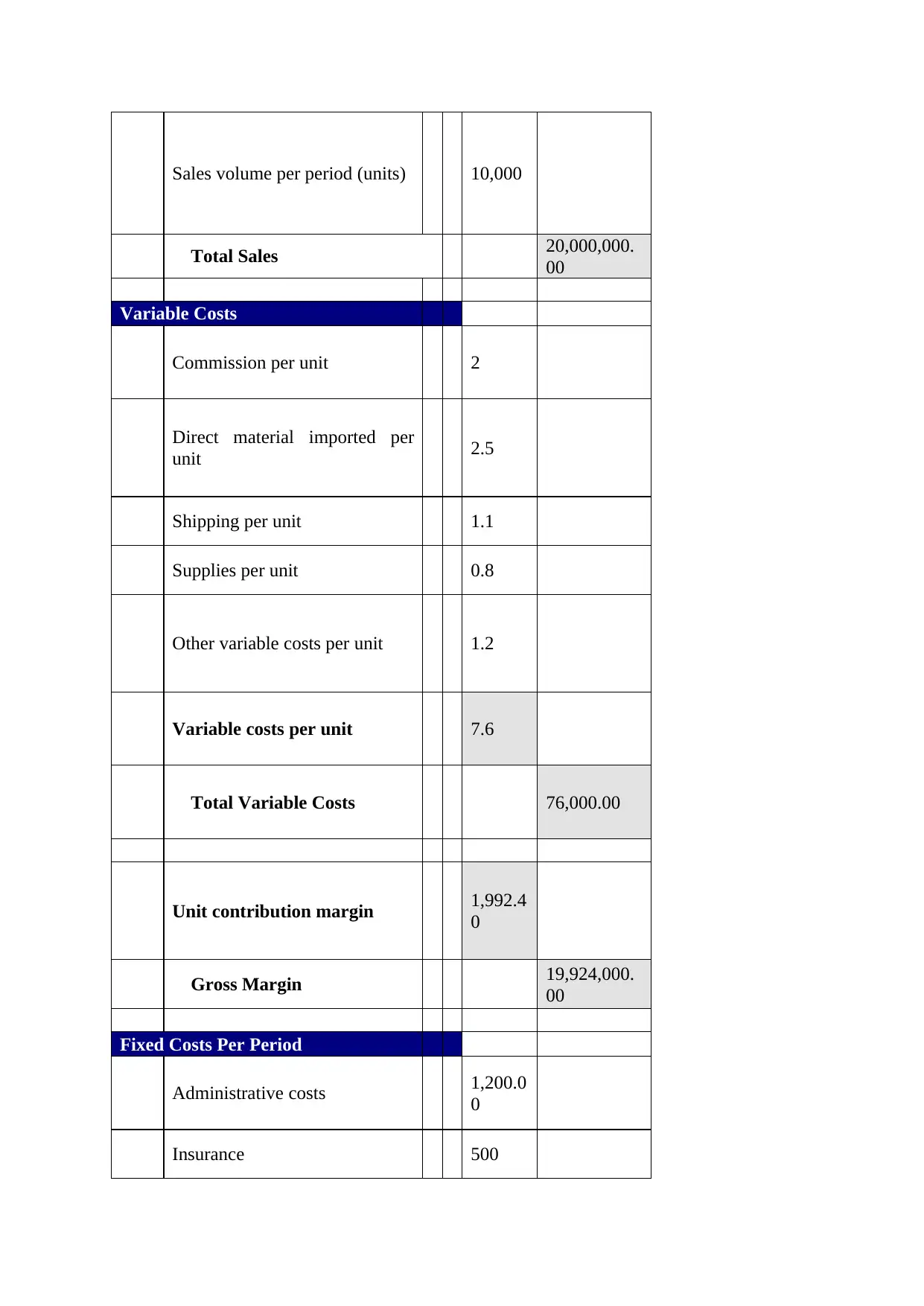
Sales volume per period (units) 10,000
Total Sales 20,000,000.
00
Variable Costs
Commission per unit 2
Direct material imported per
unit 2.5
Shipping per unit 1.1
Supplies per unit 0.8
Other variable costs per unit 1.2
Variable costs per unit 7.6
Total Variable Costs 76,000.00
Unit contribution margin 1,992.4
0
Gross Margin 19,924,000.
00
Fixed Costs Per Period
Administrative costs 1,200.0
0
Insurance 500
Total Sales 20,000,000.
00
Variable Costs
Commission per unit 2
Direct material imported per
unit 2.5
Shipping per unit 1.1
Supplies per unit 0.8
Other variable costs per unit 1.2
Variable costs per unit 7.6
Total Variable Costs 76,000.00
Unit contribution margin 1,992.4
0
Gross Margin 19,924,000.
00
Fixed Costs Per Period
Administrative costs 1,200.0
0
Insurance 500
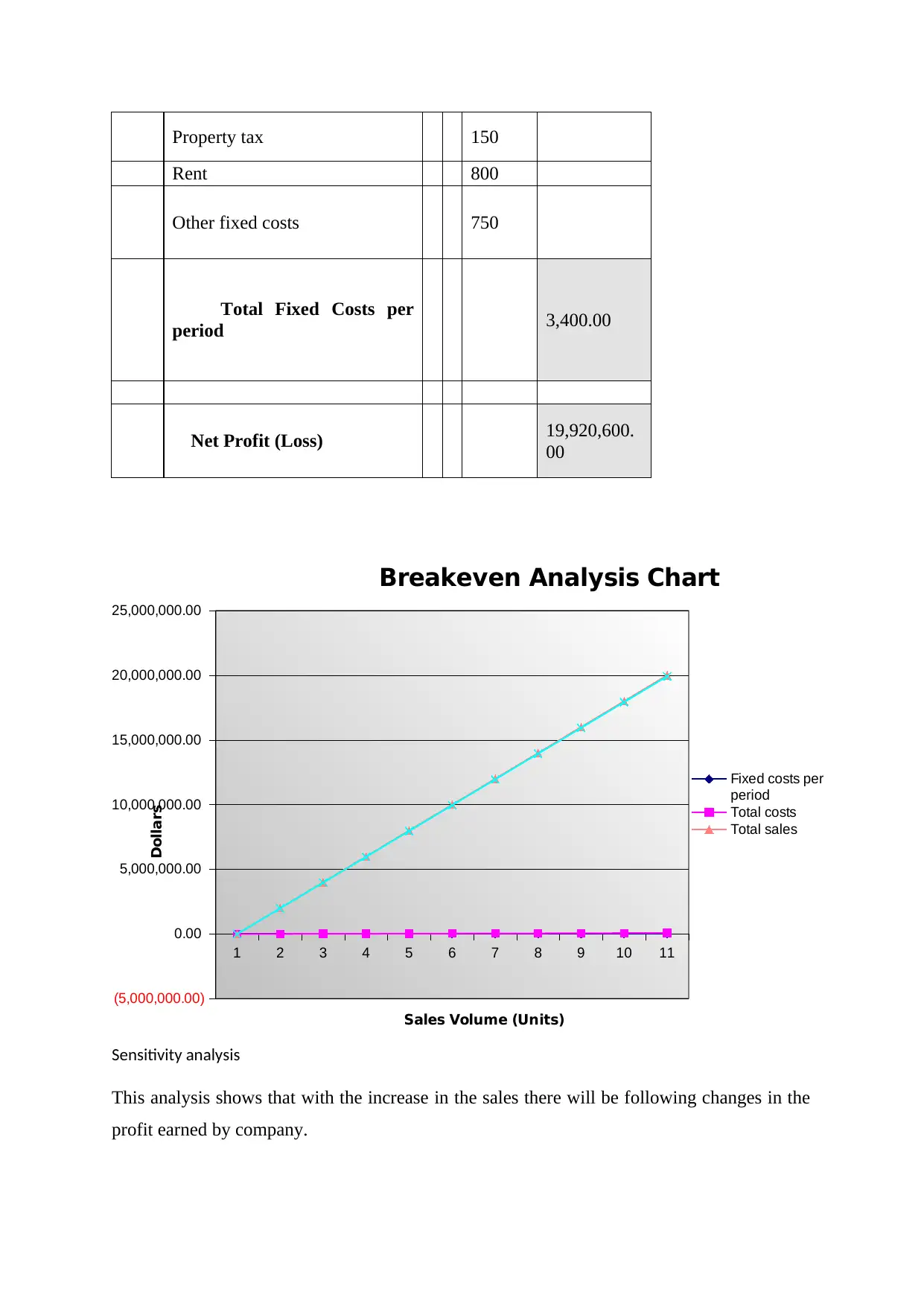
Property tax 150
Rent 800
Other fixed costs 750
Total Fixed Costs per
period 3,400.00
Net Profit (Loss) 19,920,600.
00
1 2 3 4 5 6 7 8 9 10 11
(5,000,000.00)
0.00
5,000,000.00
10,000,000.00
15,000,000.00
20,000,000.00
25,000,000.00
Breakeven Analysis Chart
Fixed costs per
period
Total costs
Total sales
Sales Volume (Units)
Dollars
Sensitivity analysis
This analysis shows that with the increase in the sales there will be following changes in the
profit earned by company.
Rent 800
Other fixed costs 750
Total Fixed Costs per
period 3,400.00
Net Profit (Loss) 19,920,600.
00
1 2 3 4 5 6 7 8 9 10 11
(5,000,000.00)
0.00
5,000,000.00
10,000,000.00
15,000,000.00
20,000,000.00
25,000,000.00
Breakeven Analysis Chart
Fixed costs per
period
Total costs
Total sales
Sales Volume (Units)
Dollars
Sensitivity analysis
This analysis shows that with the increase in the sales there will be following changes in the
profit earned by company.
Paraphrase This Document
Need a fresh take? Get an instant paraphrase of this document with our AI Paraphraser

Average
clothing
Sales 0
1,00
0
2,00
0
3,00
0
4,00
0
5,00
0
6,00
0
7,00
0
8,00
0
9,00
0
10,0
00
Sales
price per
unit
2,0
00.
00
2,00
0.00
2,00
0.00
2,00
0.00
2,00
0.00
2,00
0.00
2,00
0.00
2,00
0.00
2,00
0.00
2,00
0.00
2,00
0.00
Fixed
costs per
period
3,4
00.
00
3,40
0.00
3,40
0.00
3,40
0.00
3,40
0.00
3,40
0.00
3,40
0.00
3,40
0.00
3,40
0.00
3,40
0.00
3,40
0.00
Variabl
e costs
0.0
0
7,60
0.00
15,2
00.0
0
22,8
00.0
0
30,4
00.0
0
38,0
00.0
0
45,6
00.0
0
53,2
00.0
0
60,8
00.0
0
68,4
00.0
0
76,0
00.0
0
Total
costs
3,4
00.
00
11,0
00.0
0
18,6
00.0
0
26,2
00.0
0
33,8
00.0
0
41,4
00.0
0
49,0
00.0
0
56,6
00.0
0
64,2
00.0
0
71,8
00.0
0
79,4
00.0
0
Total
sales
0.0
0
2,00
0,00
0.00
4,00
0,00
0.00
6,00
0,00
0.00
8,00
0,00
0.00
10,0
00,0
00.0
0
12,0
00,0
00.0
0
14,0
00,0
00.0
0
16,0
00,0
00.0
0
18,0
00,0
00.0
0
20,0
00,0
00.0
0
Net
profit
(loss)
-
3,4
00.
00
1,98
9,00
0.00
3,98
1,40
0.00
5,97
3,80
0.00
7,96
6,20
0.00
9,95
8,60
0.00
11,9
51,0
00.0
0
13,9
43,4
00.0
0
15,9
35,8
00.0
0
17,9
28,2
00.0
0
19,9
20,6
00.0
0
(Miller-Nobles, Mattison, and Matsumura, 2016).
clothing
Sales 0
1,00
0
2,00
0
3,00
0
4,00
0
5,00
0
6,00
0
7,00
0
8,00
0
9,00
0
10,0
00
Sales
price per
unit
2,0
00.
00
2,00
0.00
2,00
0.00
2,00
0.00
2,00
0.00
2,00
0.00
2,00
0.00
2,00
0.00
2,00
0.00
2,00
0.00
2,00
0.00
Fixed
costs per
period
3,4
00.
00
3,40
0.00
3,40
0.00
3,40
0.00
3,40
0.00
3,40
0.00
3,40
0.00
3,40
0.00
3,40
0.00
3,40
0.00
3,40
0.00
Variabl
e costs
0.0
0
7,60
0.00
15,2
00.0
0
22,8
00.0
0
30,4
00.0
0
38,0
00.0
0
45,6
00.0
0
53,2
00.0
0
60,8
00.0
0
68,4
00.0
0
76,0
00.0
0
Total
costs
3,4
00.
00
11,0
00.0
0
18,6
00.0
0
26,2
00.0
0
33,8
00.0
0
41,4
00.0
0
49,0
00.0
0
56,6
00.0
0
64,2
00.0
0
71,8
00.0
0
79,4
00.0
0
Total
sales
0.0
0
2,00
0,00
0.00
4,00
0,00
0.00
6,00
0,00
0.00
8,00
0,00
0.00
10,0
00,0
00.0
0
12,0
00,0
00.0
0
14,0
00,0
00.0
0
16,0
00,0
00.0
0
18,0
00,0
00.0
0
20,0
00,0
00.0
0
Net
profit
(loss)
-
3,4
00.
00
1,98
9,00
0.00
3,98
1,40
0.00
5,97
3,80
0.00
7,96
6,20
0.00
9,95
8,60
0.00
11,9
51,0
00.0
0
13,9
43,4
00.0
0
15,9
35,8
00.0
0
17,9
28,2
00.0
0
19,9
20,6
00.0
0
(Miller-Nobles, Mattison, and Matsumura, 2016).

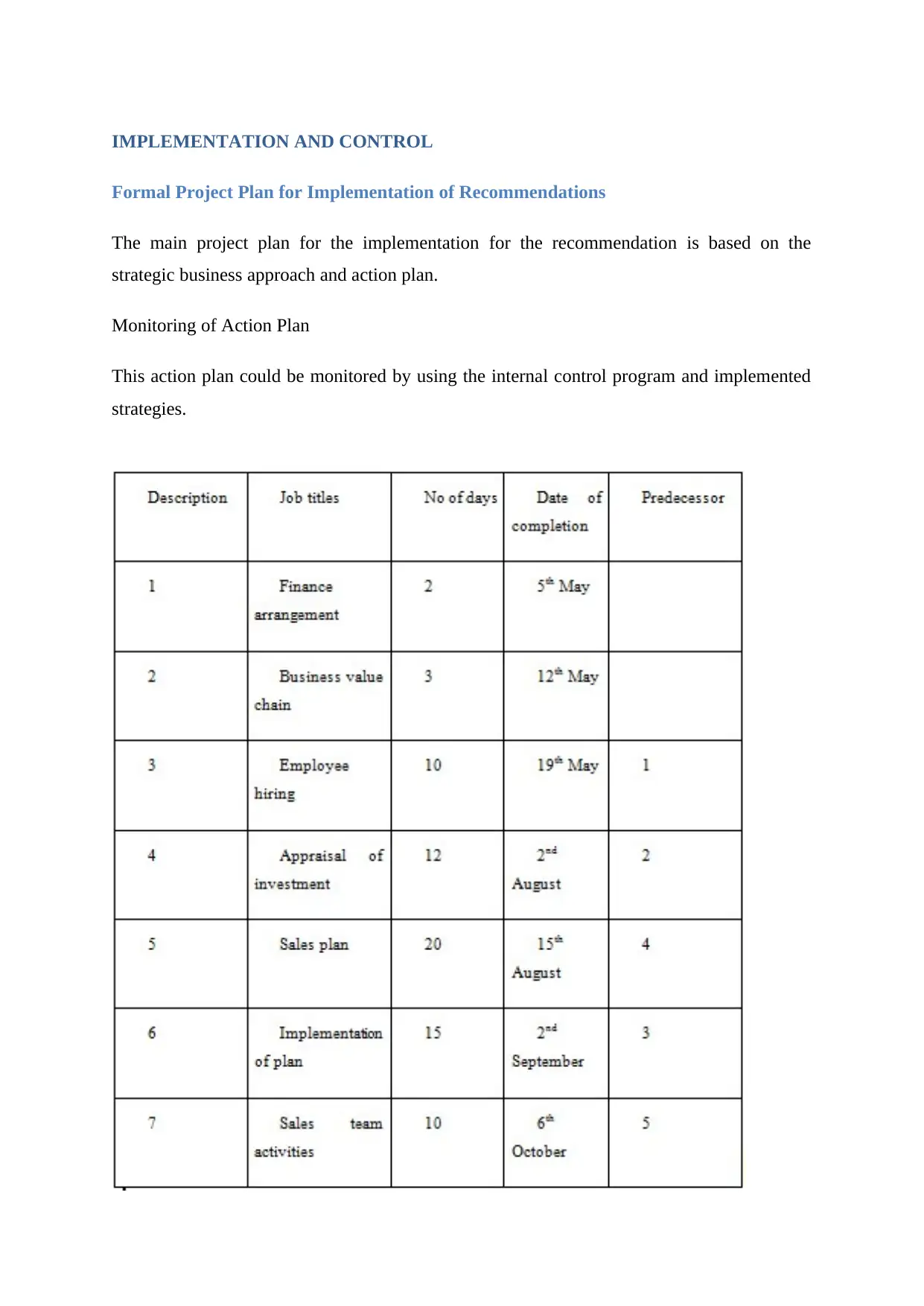
IMPLEMENTATION AND CONTROL
Formal Project Plan for Implementation of Recommendations
The main project plan for the implementation for the recommendation is based on the
strategic business approach and action plan.
Monitoring of Action Plan
This action plan could be monitored by using the internal control program and implemented
strategies.
Formal Project Plan for Implementation of Recommendations
The main project plan for the implementation for the recommendation is based on the
strategic business approach and action plan.
Monitoring of Action Plan
This action plan could be monitored by using the internal control program and implemented
strategies.
Secure Best Marks with AI Grader
Need help grading? Try our AI Grader for instant feedback on your assignments.
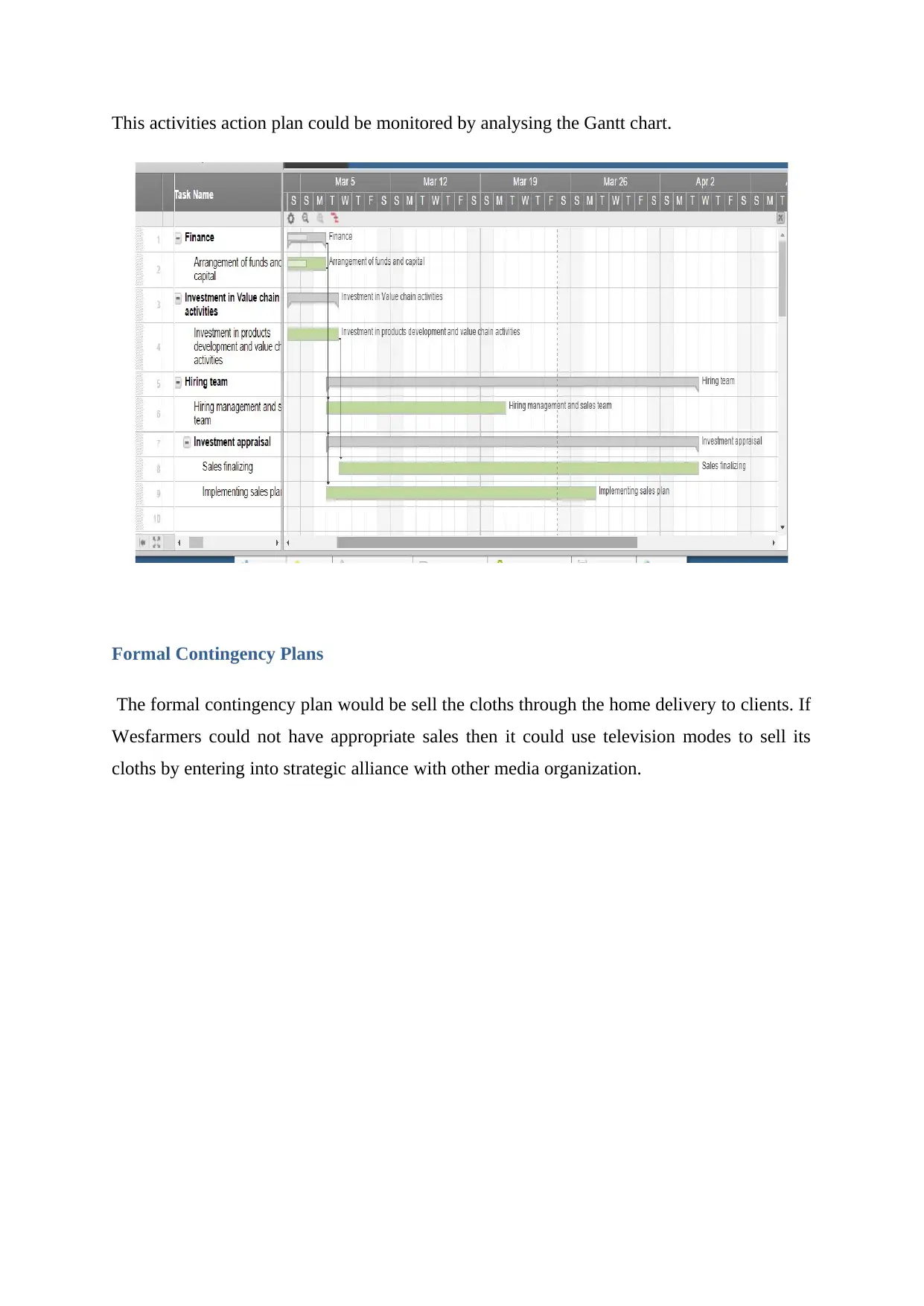
This activities action plan could be monitored by analysing the Gantt chart.
Formal Contingency Plans
The formal contingency plan would be sell the cloths through the home delivery to clients. If
Wesfarmers could not have appropriate sales then it could use television modes to sell its
cloths by entering into strategic alliance with other media organization.
Formal Contingency Plans
The formal contingency plan would be sell the cloths through the home delivery to clients. If
Wesfarmers could not have appropriate sales then it could use television modes to sell its
cloths by entering into strategic alliance with other media organization.
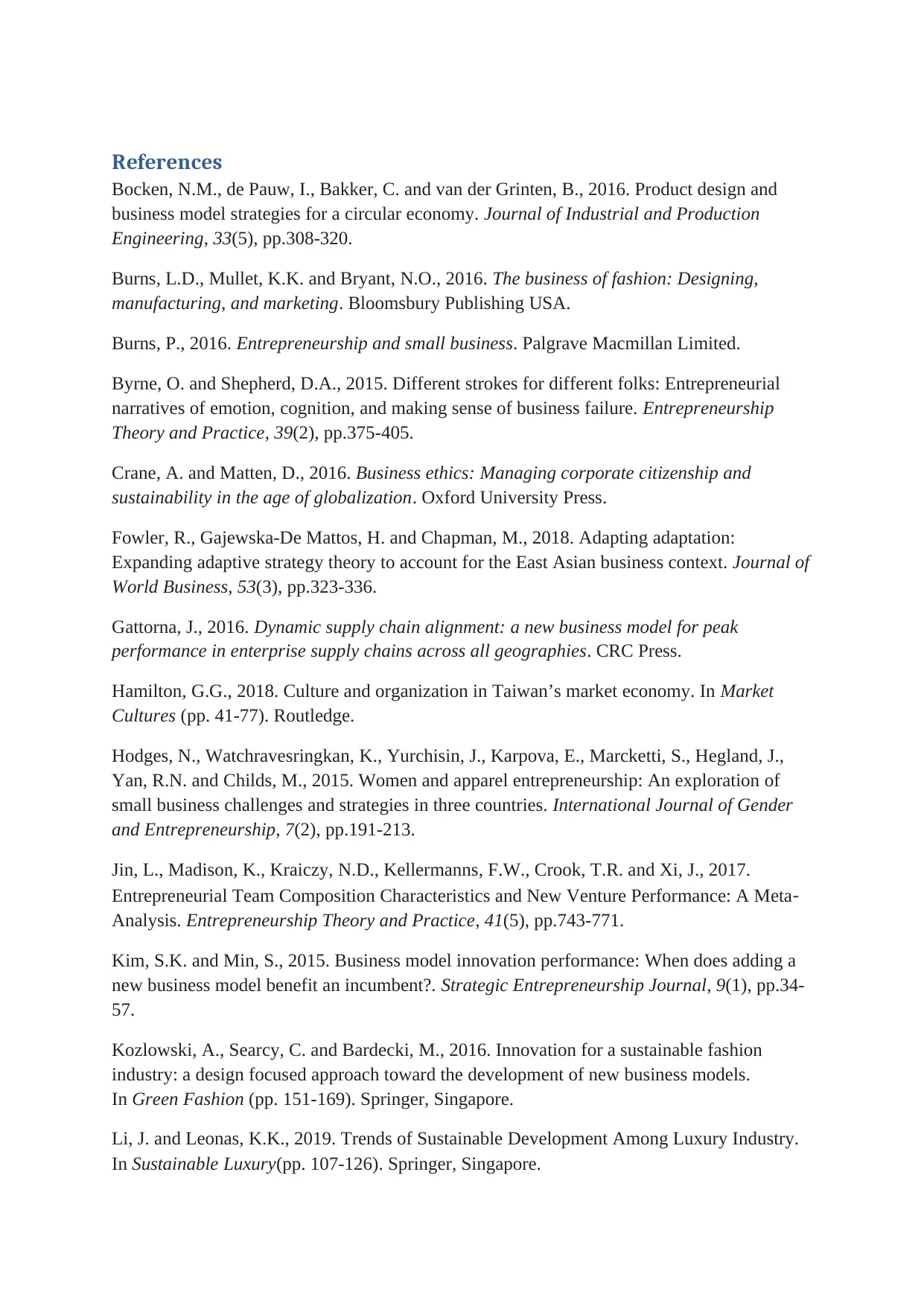
References
Bocken, N.M., de Pauw, I., Bakker, C. and van der Grinten, B., 2016. Product design and
business model strategies for a circular economy. Journal of Industrial and Production
Engineering, 33(5), pp.308-320.
Burns, L.D., Mullet, K.K. and Bryant, N.O., 2016. The business of fashion: Designing,
manufacturing, and marketing. Bloomsbury Publishing USA.
Burns, P., 2016. Entrepreneurship and small business. Palgrave Macmillan Limited.
Byrne, O. and Shepherd, D.A., 2015. Different strokes for different folks: Entrepreneurial
narratives of emotion, cognition, and making sense of business failure. Entrepreneurship
Theory and Practice, 39(2), pp.375-405.
Crane, A. and Matten, D., 2016. Business ethics: Managing corporate citizenship and
sustainability in the age of globalization. Oxford University Press.
Fowler, R., Gajewska-De Mattos, H. and Chapman, M., 2018. Adapting adaptation:
Expanding adaptive strategy theory to account for the East Asian business context. Journal of
World Business, 53(3), pp.323-336.
Gattorna, J., 2016. Dynamic supply chain alignment: a new business model for peak
performance in enterprise supply chains across all geographies. CRC Press.
Hamilton, G.G., 2018. Culture and organization in Taiwan’s market economy. In Market
Cultures (pp. 41-77). Routledge.
Hodges, N., Watchravesringkan, K., Yurchisin, J., Karpova, E., Marcketti, S., Hegland, J.,
Yan, R.N. and Childs, M., 2015. Women and apparel entrepreneurship: An exploration of
small business challenges and strategies in three countries. International Journal of Gender
and Entrepreneurship, 7(2), pp.191-213.
Jin, L., Madison, K., Kraiczy, N.D., Kellermanns, F.W., Crook, T.R. and Xi, J., 2017.
Entrepreneurial Team Composition Characteristics and New Venture Performance: A Meta‐
Analysis. Entrepreneurship Theory and Practice, 41(5), pp.743-771.
Kim, S.K. and Min, S., 2015. Business model innovation performance: When does adding a
new business model benefit an incumbent?. Strategic Entrepreneurship Journal, 9(1), pp.34-
57.
Kozlowski, A., Searcy, C. and Bardecki, M., 2016. Innovation for a sustainable fashion
industry: a design focused approach toward the development of new business models.
In Green Fashion (pp. 151-169). Springer, Singapore.
Li, J. and Leonas, K.K., 2019. Trends of Sustainable Development Among Luxury Industry.
In Sustainable Luxury(pp. 107-126). Springer, Singapore.
Bocken, N.M., de Pauw, I., Bakker, C. and van der Grinten, B., 2016. Product design and
business model strategies for a circular economy. Journal of Industrial and Production
Engineering, 33(5), pp.308-320.
Burns, L.D., Mullet, K.K. and Bryant, N.O., 2016. The business of fashion: Designing,
manufacturing, and marketing. Bloomsbury Publishing USA.
Burns, P., 2016. Entrepreneurship and small business. Palgrave Macmillan Limited.
Byrne, O. and Shepherd, D.A., 2015. Different strokes for different folks: Entrepreneurial
narratives of emotion, cognition, and making sense of business failure. Entrepreneurship
Theory and Practice, 39(2), pp.375-405.
Crane, A. and Matten, D., 2016. Business ethics: Managing corporate citizenship and
sustainability in the age of globalization. Oxford University Press.
Fowler, R., Gajewska-De Mattos, H. and Chapman, M., 2018. Adapting adaptation:
Expanding adaptive strategy theory to account for the East Asian business context. Journal of
World Business, 53(3), pp.323-336.
Gattorna, J., 2016. Dynamic supply chain alignment: a new business model for peak
performance in enterprise supply chains across all geographies. CRC Press.
Hamilton, G.G., 2018. Culture and organization in Taiwan’s market economy. In Market
Cultures (pp. 41-77). Routledge.
Hodges, N., Watchravesringkan, K., Yurchisin, J., Karpova, E., Marcketti, S., Hegland, J.,
Yan, R.N. and Childs, M., 2015. Women and apparel entrepreneurship: An exploration of
small business challenges and strategies in three countries. International Journal of Gender
and Entrepreneurship, 7(2), pp.191-213.
Jin, L., Madison, K., Kraiczy, N.D., Kellermanns, F.W., Crook, T.R. and Xi, J., 2017.
Entrepreneurial Team Composition Characteristics and New Venture Performance: A Meta‐
Analysis. Entrepreneurship Theory and Practice, 41(5), pp.743-771.
Kim, S.K. and Min, S., 2015. Business model innovation performance: When does adding a
new business model benefit an incumbent?. Strategic Entrepreneurship Journal, 9(1), pp.34-
57.
Kozlowski, A., Searcy, C. and Bardecki, M., 2016. Innovation for a sustainable fashion
industry: a design focused approach toward the development of new business models.
In Green Fashion (pp. 151-169). Springer, Singapore.
Li, J. and Leonas, K.K., 2019. Trends of Sustainable Development Among Luxury Industry.
In Sustainable Luxury(pp. 107-126). Springer, Singapore.
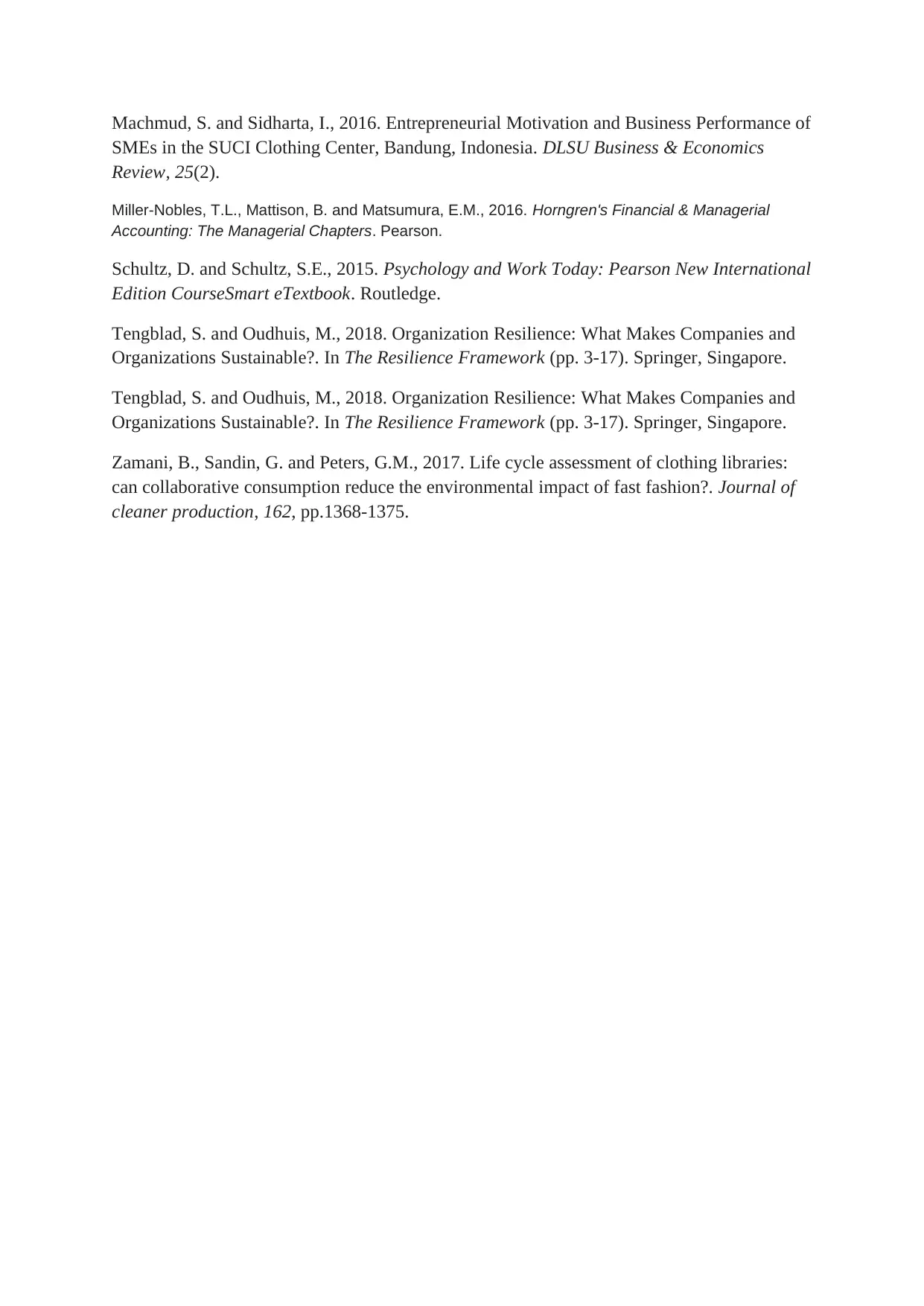
Machmud, S. and Sidharta, I., 2016. Entrepreneurial Motivation and Business Performance of
SMEs in the SUCI Clothing Center, Bandung, Indonesia. DLSU Business & Economics
Review, 25(2).
Miller-Nobles, T.L., Mattison, B. and Matsumura, E.M., 2016. Horngren's Financial & Managerial
Accounting: The Managerial Chapters. Pearson.
Schultz, D. and Schultz, S.E., 2015. Psychology and Work Today: Pearson New International
Edition CourseSmart eTextbook. Routledge.
Tengblad, S. and Oudhuis, M., 2018. Organization Resilience: What Makes Companies and
Organizations Sustainable?. In The Resilience Framework (pp. 3-17). Springer, Singapore.
Tengblad, S. and Oudhuis, M., 2018. Organization Resilience: What Makes Companies and
Organizations Sustainable?. In The Resilience Framework (pp. 3-17). Springer, Singapore.
Zamani, B., Sandin, G. and Peters, G.M., 2017. Life cycle assessment of clothing libraries:
can collaborative consumption reduce the environmental impact of fast fashion?. Journal of
cleaner production, 162, pp.1368-1375.
SMEs in the SUCI Clothing Center, Bandung, Indonesia. DLSU Business & Economics
Review, 25(2).
Miller-Nobles, T.L., Mattison, B. and Matsumura, E.M., 2016. Horngren's Financial & Managerial
Accounting: The Managerial Chapters. Pearson.
Schultz, D. and Schultz, S.E., 2015. Psychology and Work Today: Pearson New International
Edition CourseSmart eTextbook. Routledge.
Tengblad, S. and Oudhuis, M., 2018. Organization Resilience: What Makes Companies and
Organizations Sustainable?. In The Resilience Framework (pp. 3-17). Springer, Singapore.
Tengblad, S. and Oudhuis, M., 2018. Organization Resilience: What Makes Companies and
Organizations Sustainable?. In The Resilience Framework (pp. 3-17). Springer, Singapore.
Zamani, B., Sandin, G. and Peters, G.M., 2017. Life cycle assessment of clothing libraries:
can collaborative consumption reduce the environmental impact of fast fashion?. Journal of
cleaner production, 162, pp.1368-1375.
Paraphrase This Document
Need a fresh take? Get an instant paraphrase of this document with our AI Paraphraser
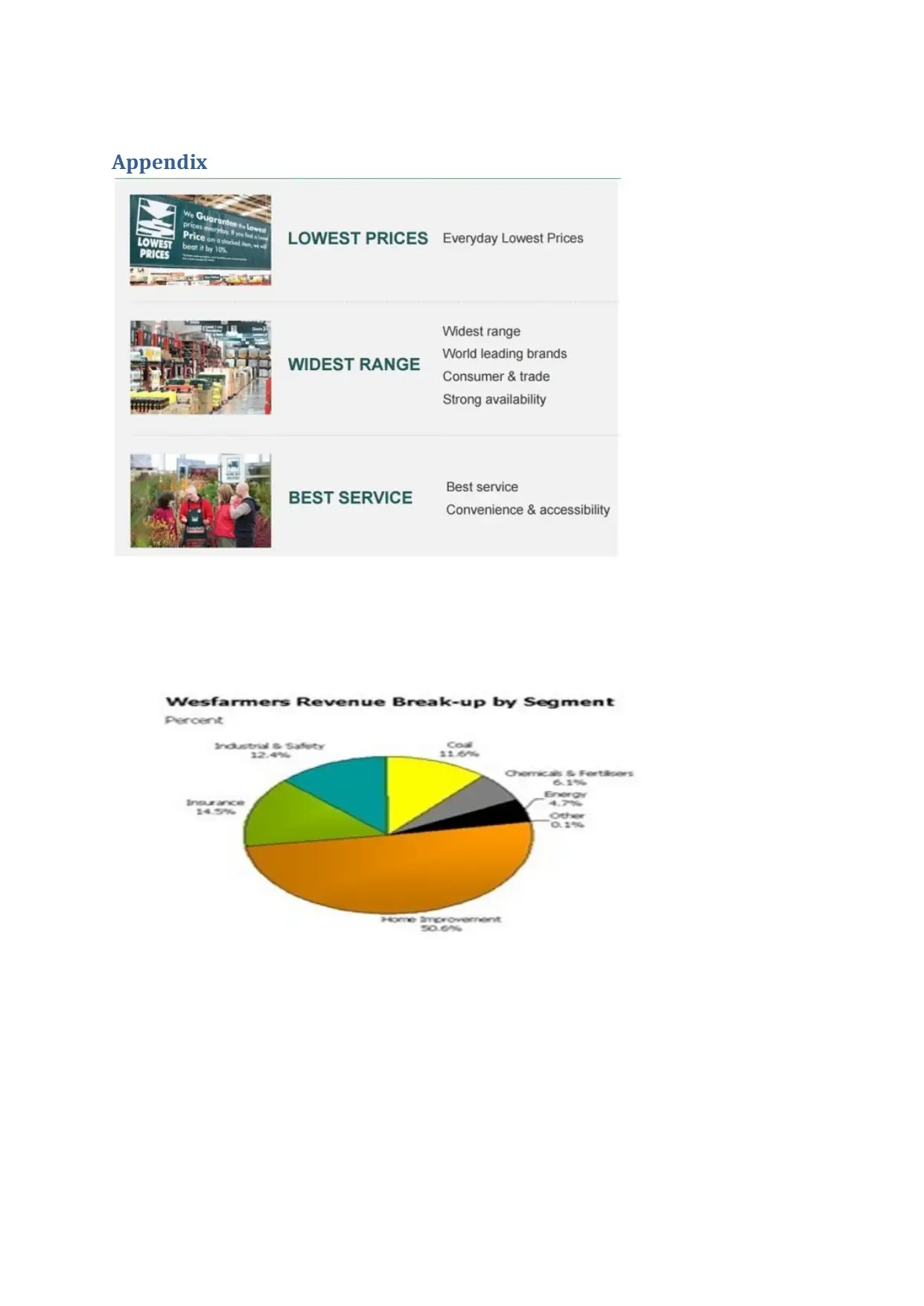
Appendix
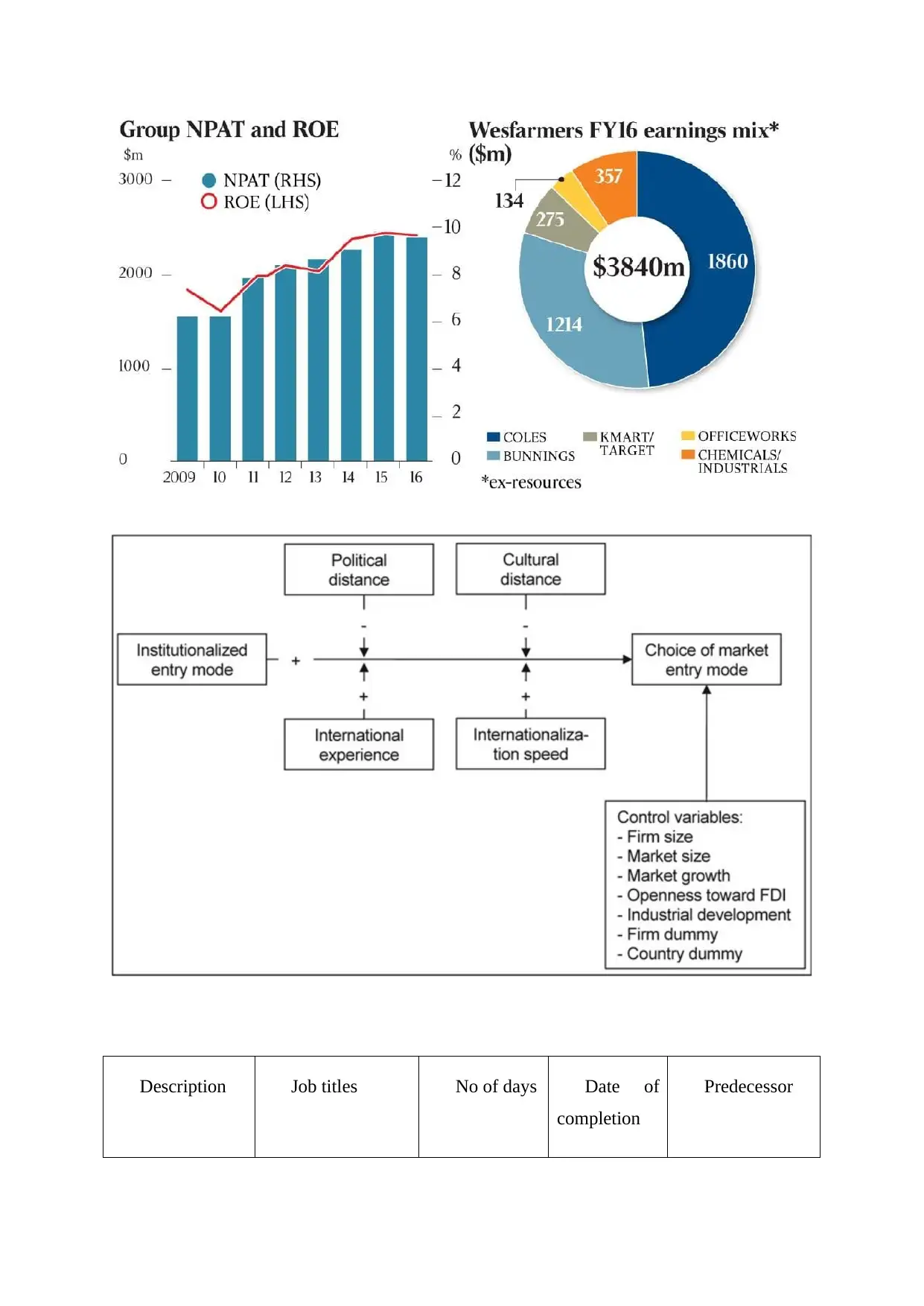
Description Job titles No of days Date of
completion
Predecessor
completion
Predecessor

1 Finance
arrangement
2 5th May
2 Business value
chain
3 12th May
3 Employee
hiring
10 19th May 1
4 Appraisal of
investment
12 2nd
August
2
5 Sales plan 20 15th
August
4
6 Implementation
of plan
15 2nd
September
3
7 Sales team
activities
10 6th
October
5
arrangement
2 5th May
2 Business value
chain
3 12th May
3 Employee
hiring
10 19th May 1
4 Appraisal of
investment
12 2nd
August
2
5 Sales plan 20 15th
August
4
6 Implementation
of plan
15 2nd
September
3
7 Sales team
activities
10 6th
October
5
Secure Best Marks with AI Grader
Need help grading? Try our AI Grader for instant feedback on your assignments.
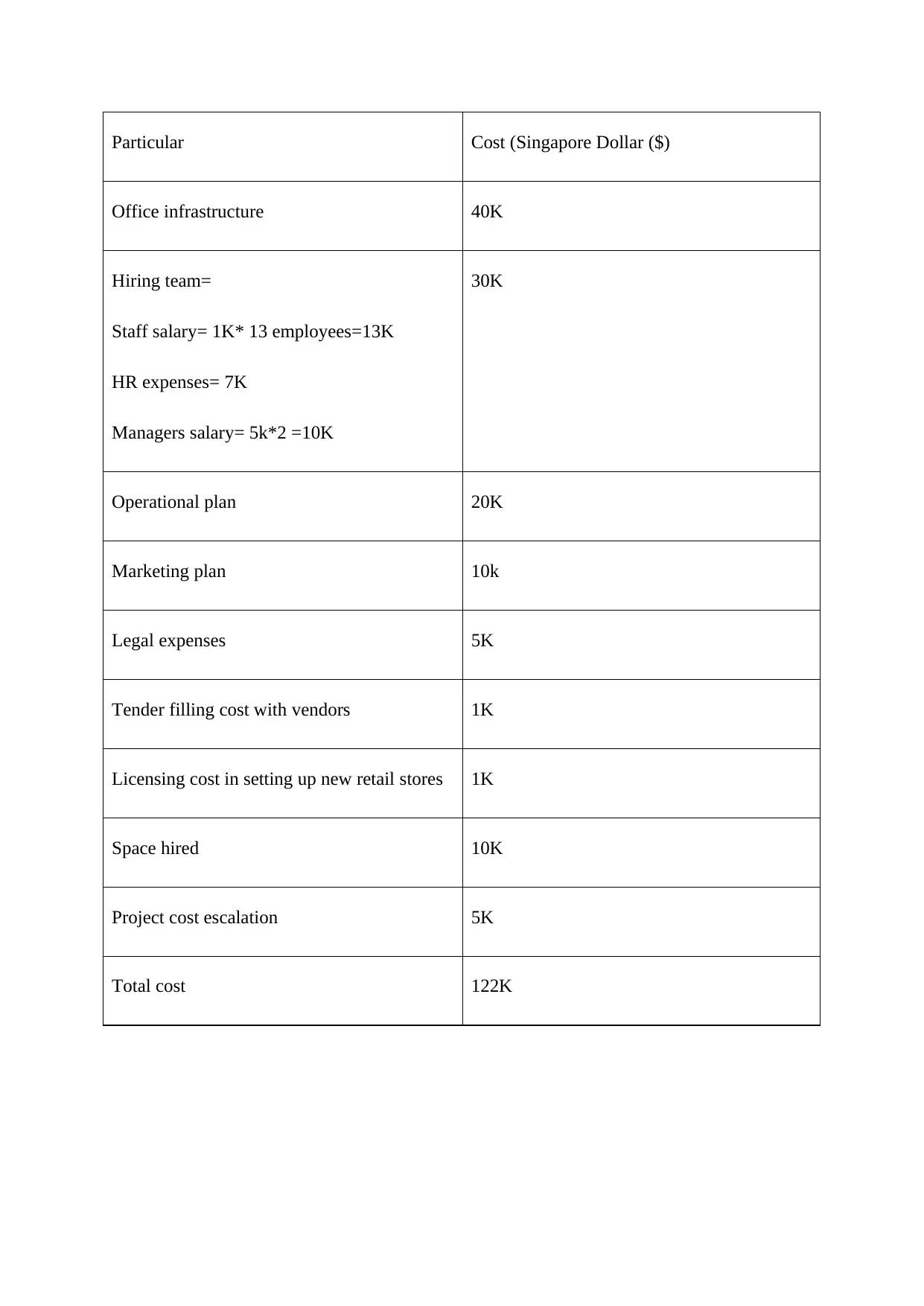
Particular Cost (Singapore Dollar ($)
Office infrastructure 40K
Hiring team=
Staff salary= 1K* 13 employees=13K
HR expenses= 7K
Managers salary= 5k*2 =10K
30K
Operational plan 20K
Marketing plan 10k
Legal expenses 5K
Tender filling cost with vendors 1K
Licensing cost in setting up new retail stores 1K
Space hired 10K
Project cost escalation 5K
Total cost 122K
Office infrastructure 40K
Hiring team=
Staff salary= 1K* 13 employees=13K
HR expenses= 7K
Managers salary= 5k*2 =10K
30K
Operational plan 20K
Marketing plan 10k
Legal expenses 5K
Tender filling cost with vendors 1K
Licensing cost in setting up new retail stores 1K
Space hired 10K
Project cost escalation 5K
Total cost 122K
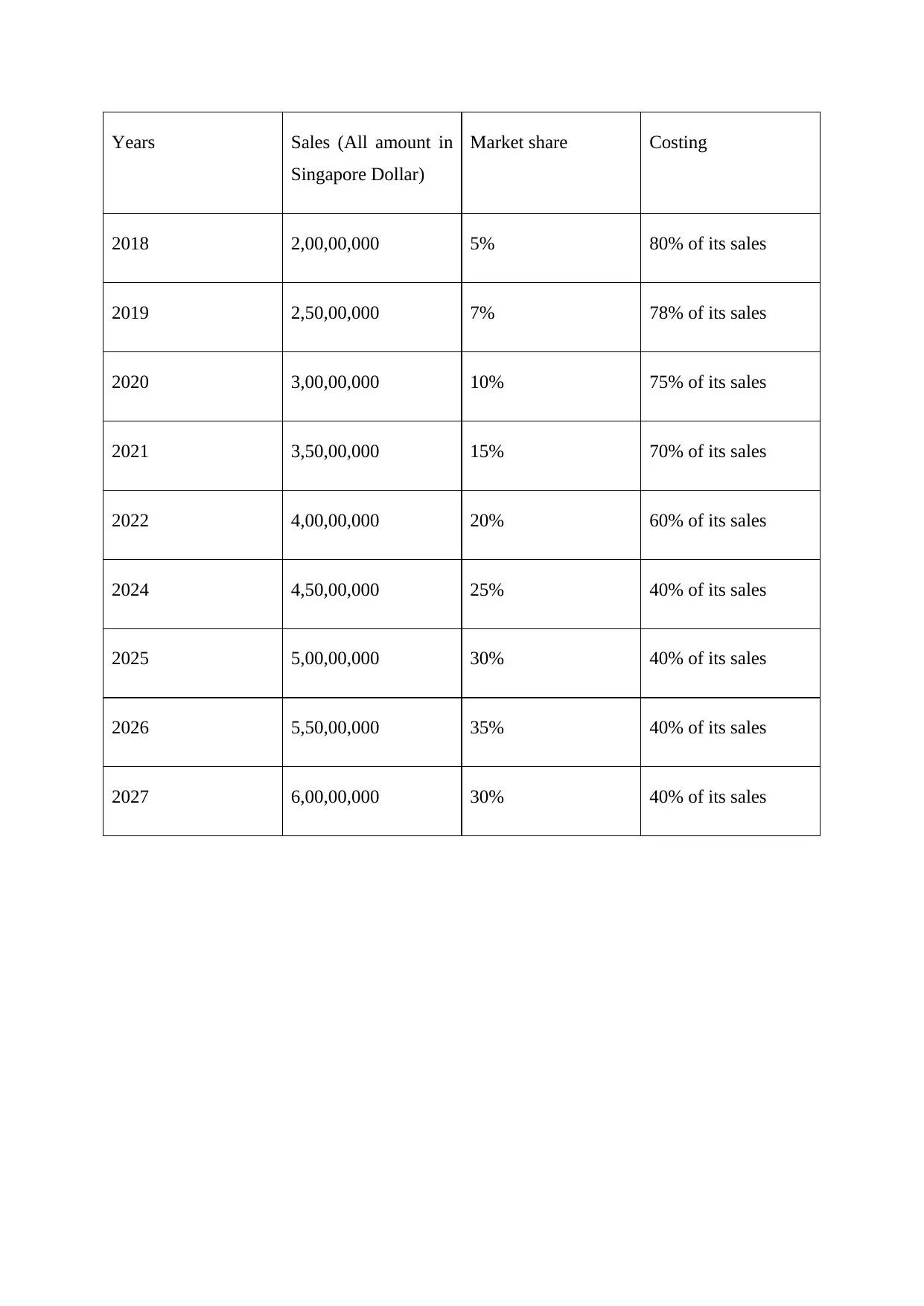
Years Sales (All amount in
Singapore Dollar)
Market share Costing
2018 2,00,00,000 5% 80% of its sales
2019 2,50,00,000 7% 78% of its sales
2020 3,00,00,000 10% 75% of its sales
2021 3,50,00,000 15% 70% of its sales
2022 4,00,00,000 20% 60% of its sales
2024 4,50,00,000 25% 40% of its sales
2025 5,00,00,000 30% 40% of its sales
2026 5,50,00,000 35% 40% of its sales
2027 6,00,00,000 30% 40% of its sales
Singapore Dollar)
Market share Costing
2018 2,00,00,000 5% 80% of its sales
2019 2,50,00,000 7% 78% of its sales
2020 3,00,00,000 10% 75% of its sales
2021 3,50,00,000 15% 70% of its sales
2022 4,00,00,000 20% 60% of its sales
2024 4,50,00,000 25% 40% of its sales
2025 5,00,00,000 30% 40% of its sales
2026 5,50,00,000 35% 40% of its sales
2027 6,00,00,000 30% 40% of its sales
1 out of 30
Related Documents
Your All-in-One AI-Powered Toolkit for Academic Success.
+13062052269
info@desklib.com
Available 24*7 on WhatsApp / Email
![[object Object]](/_next/static/media/star-bottom.7253800d.svg)
Unlock your academic potential
© 2024 | Zucol Services PVT LTD | All rights reserved.





